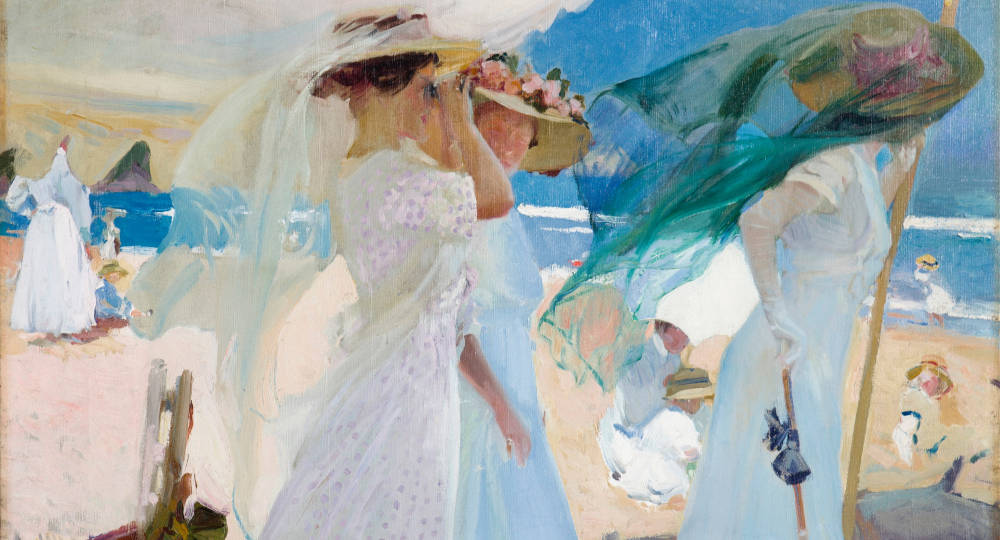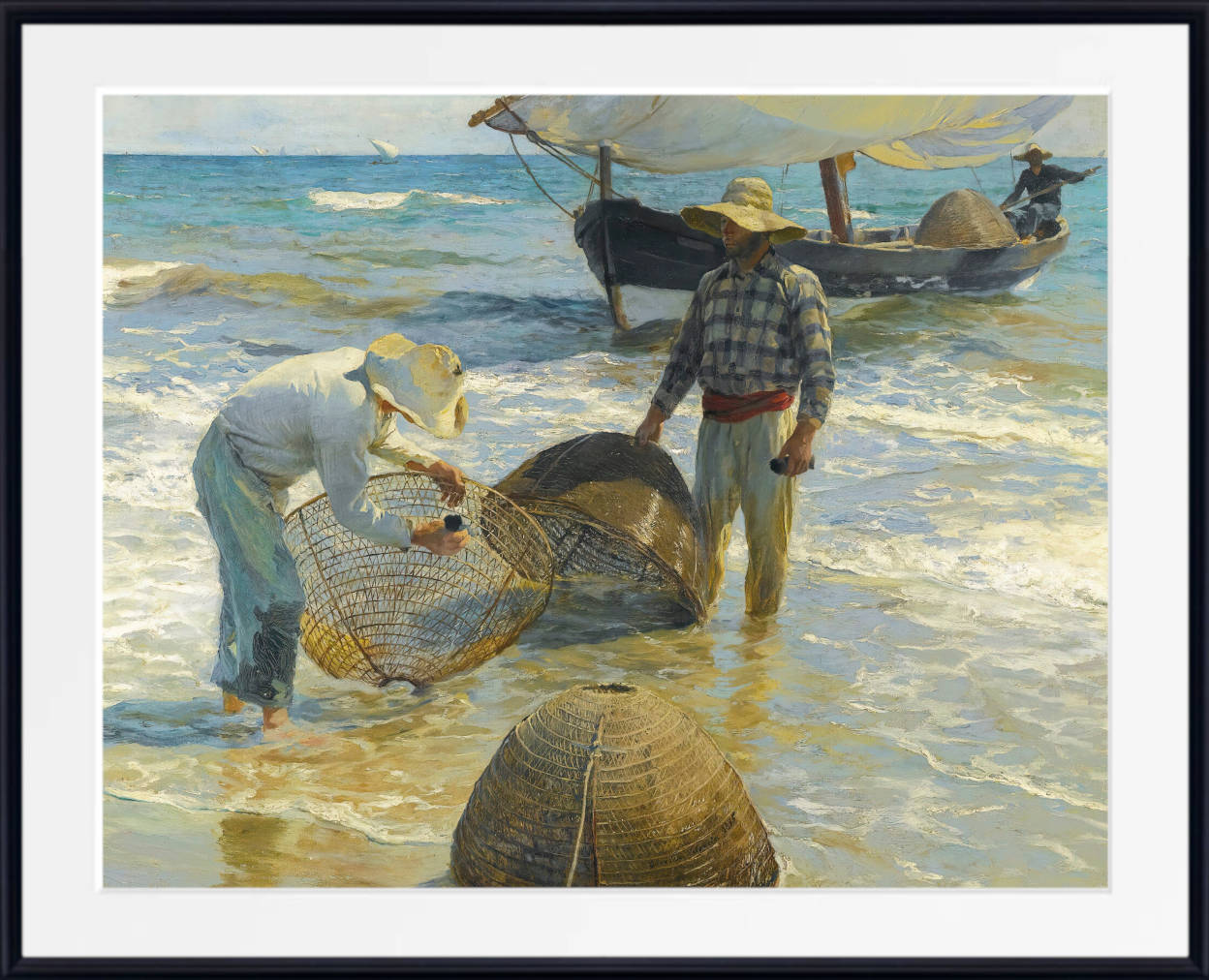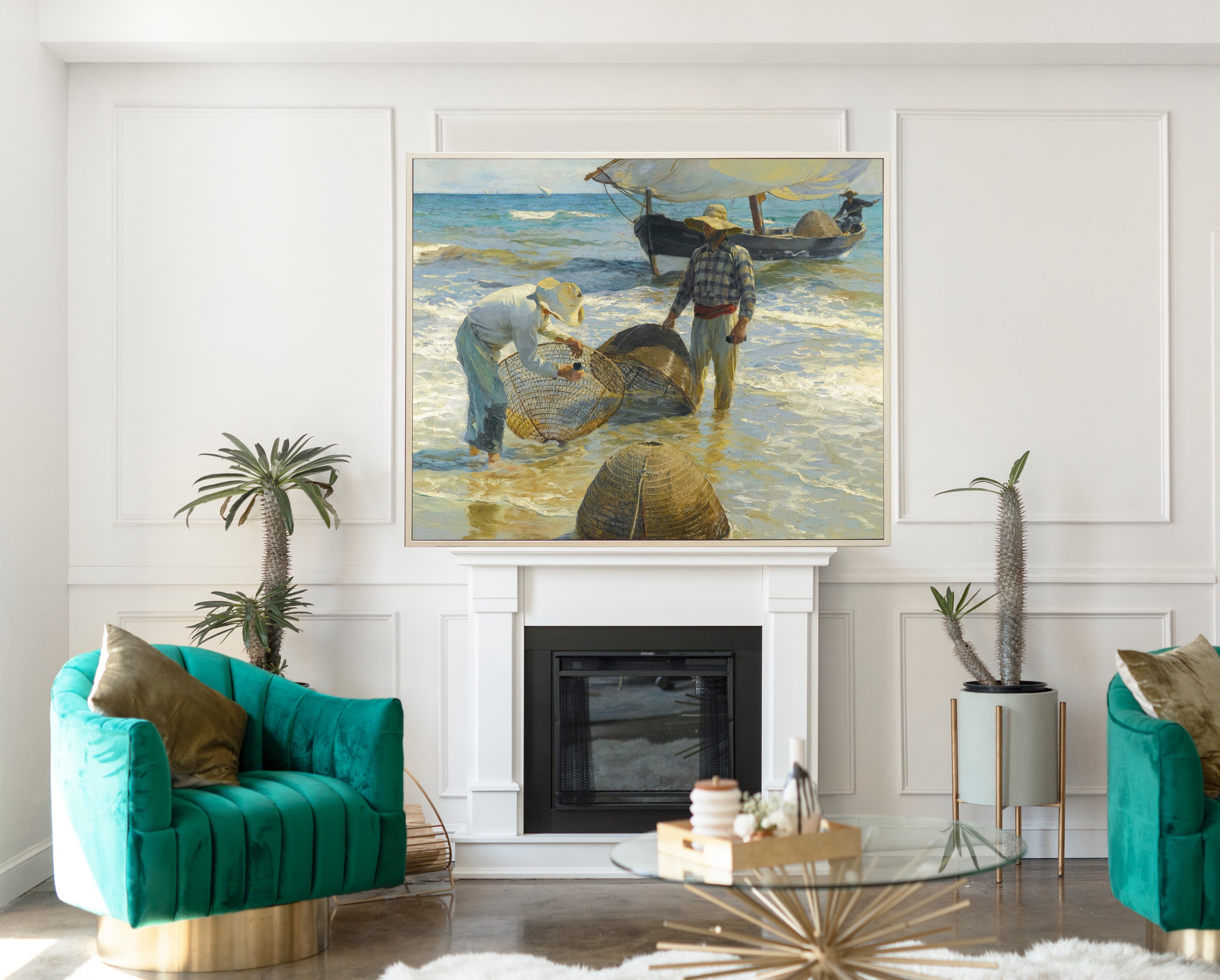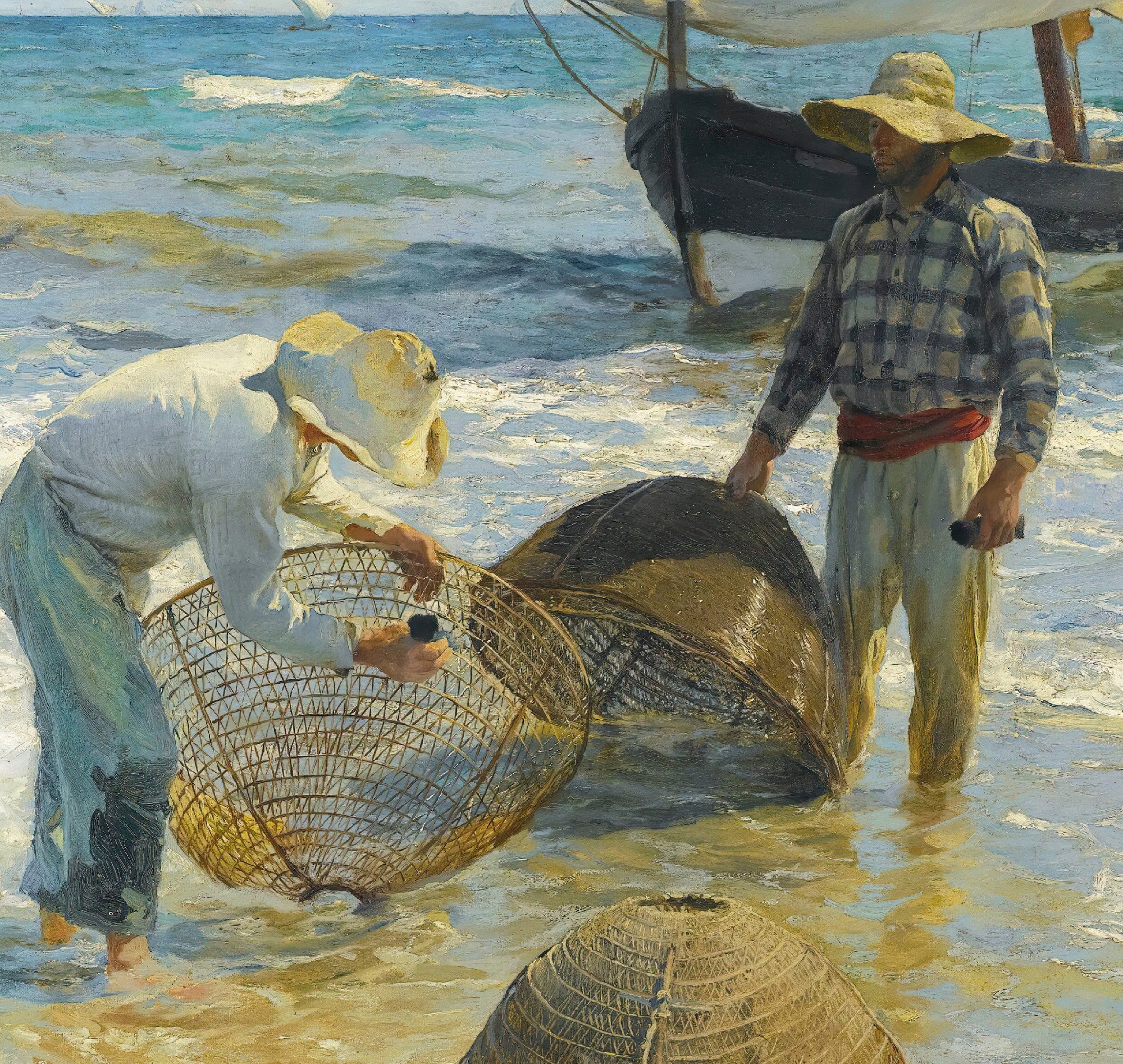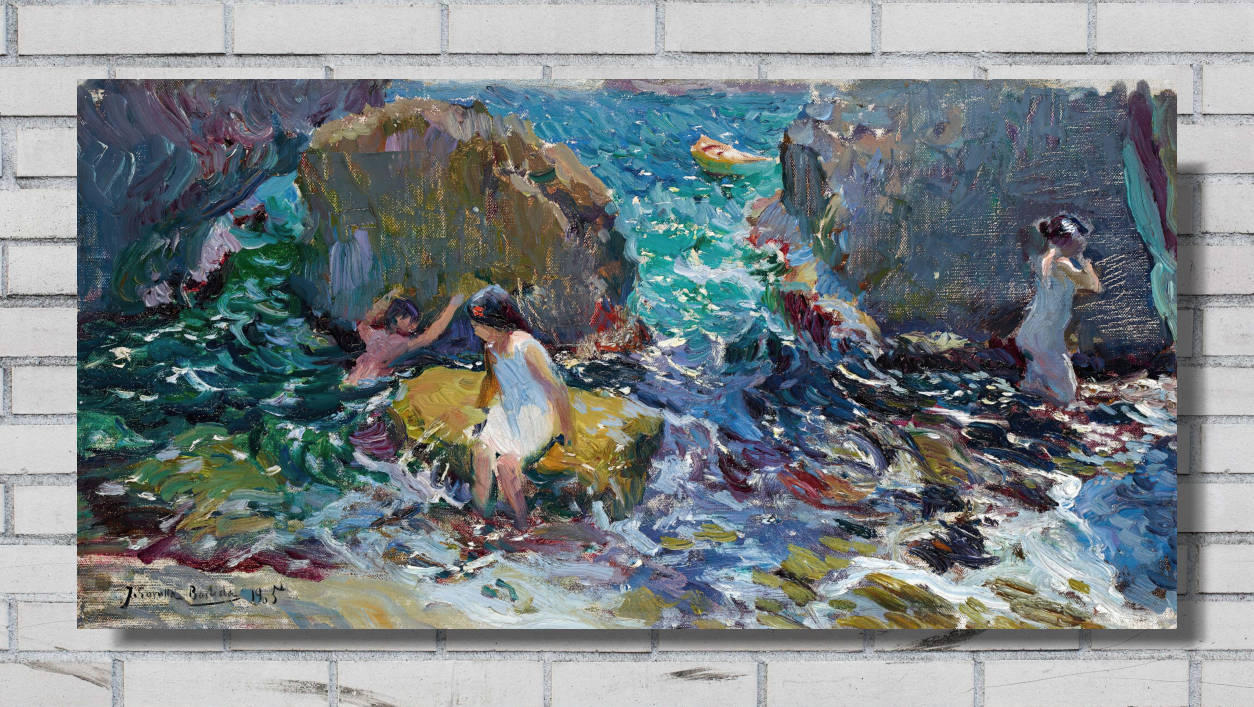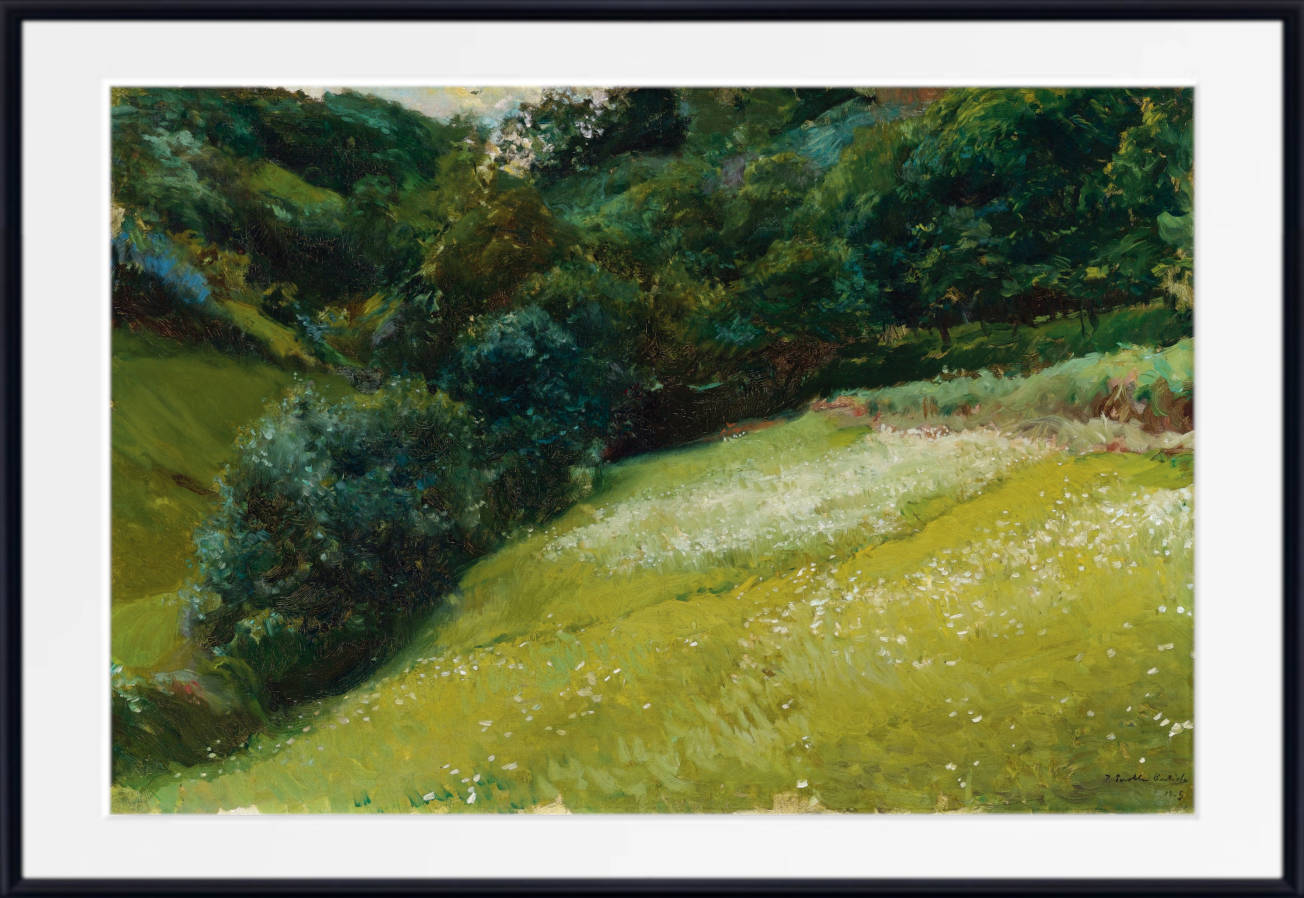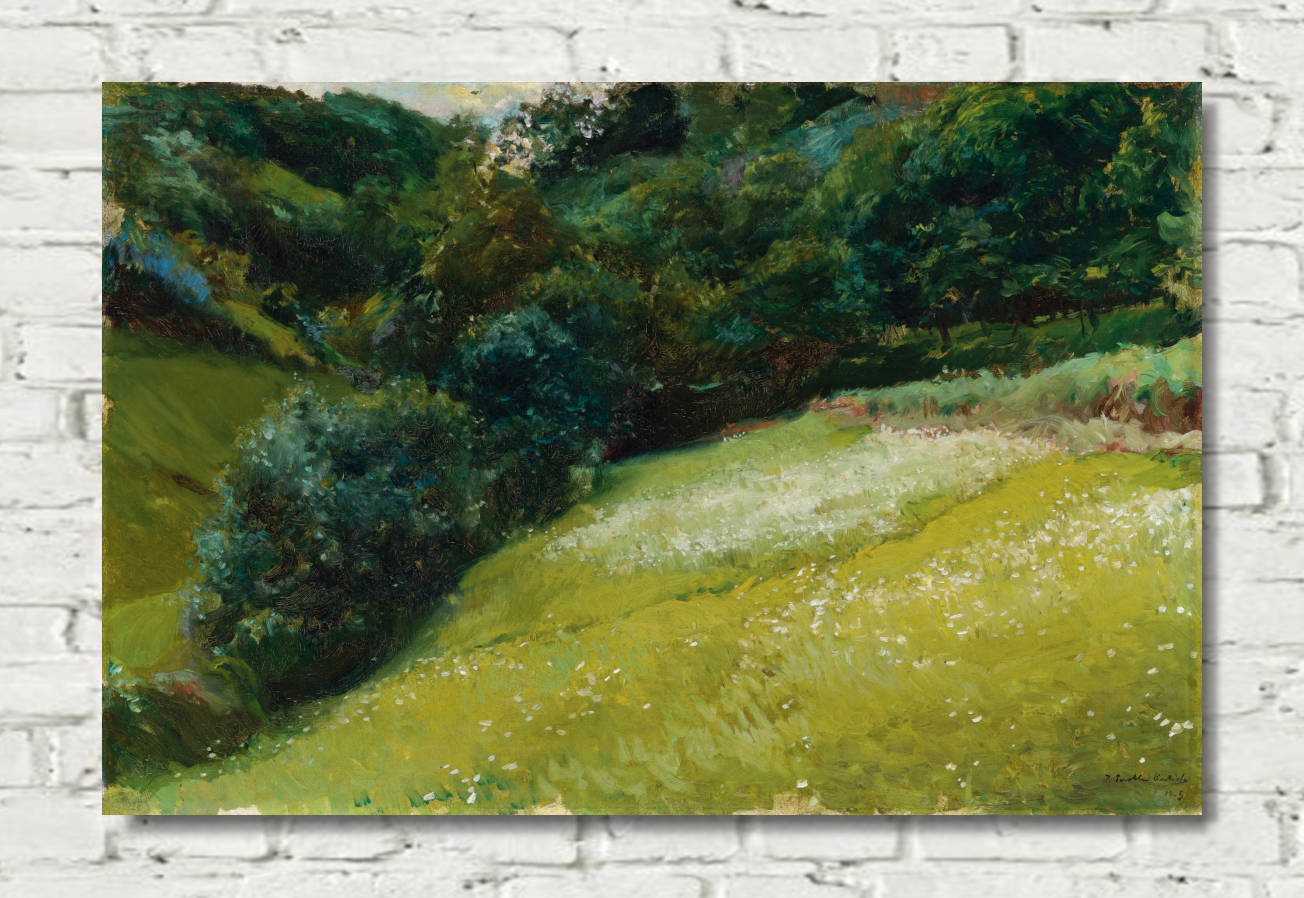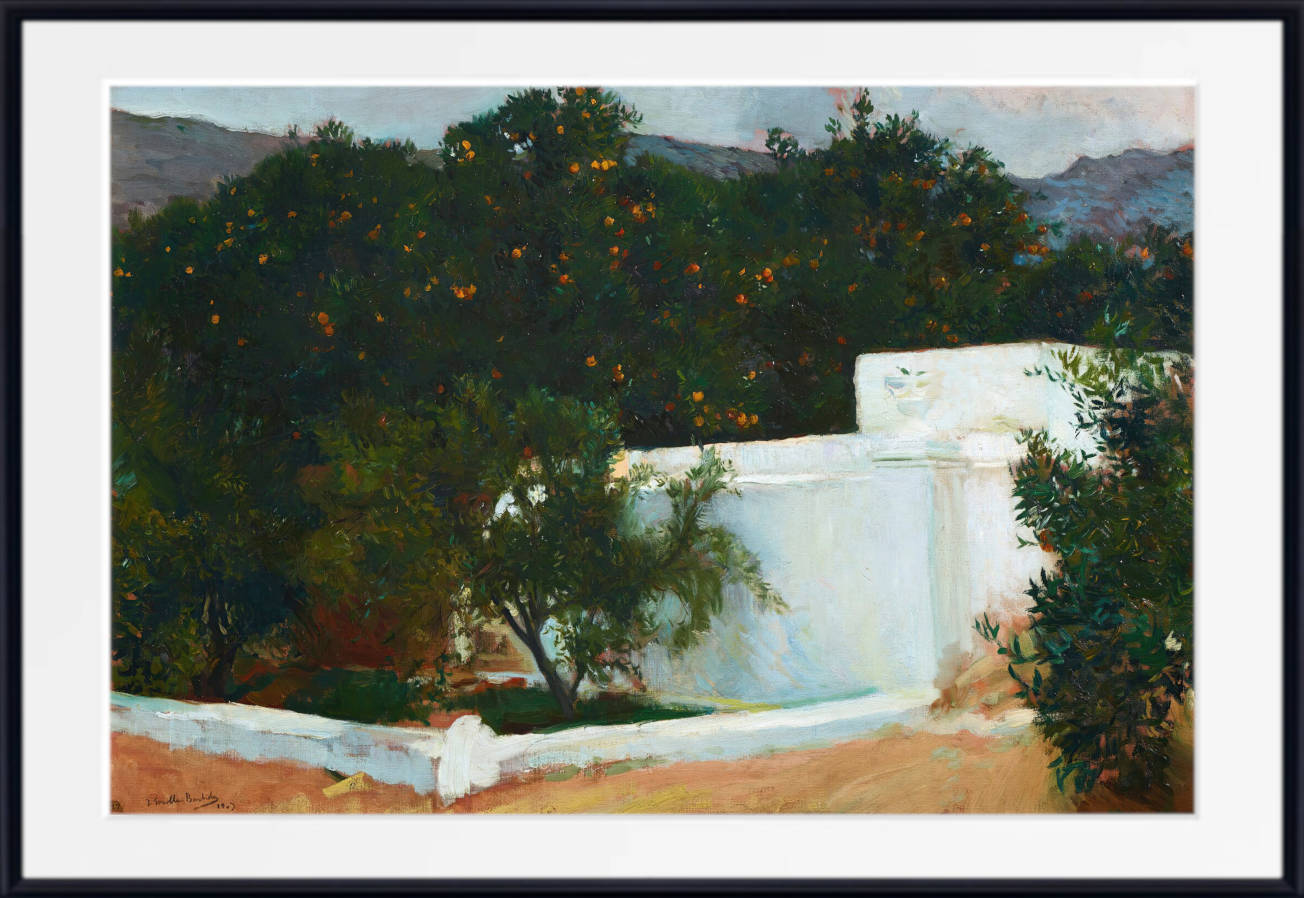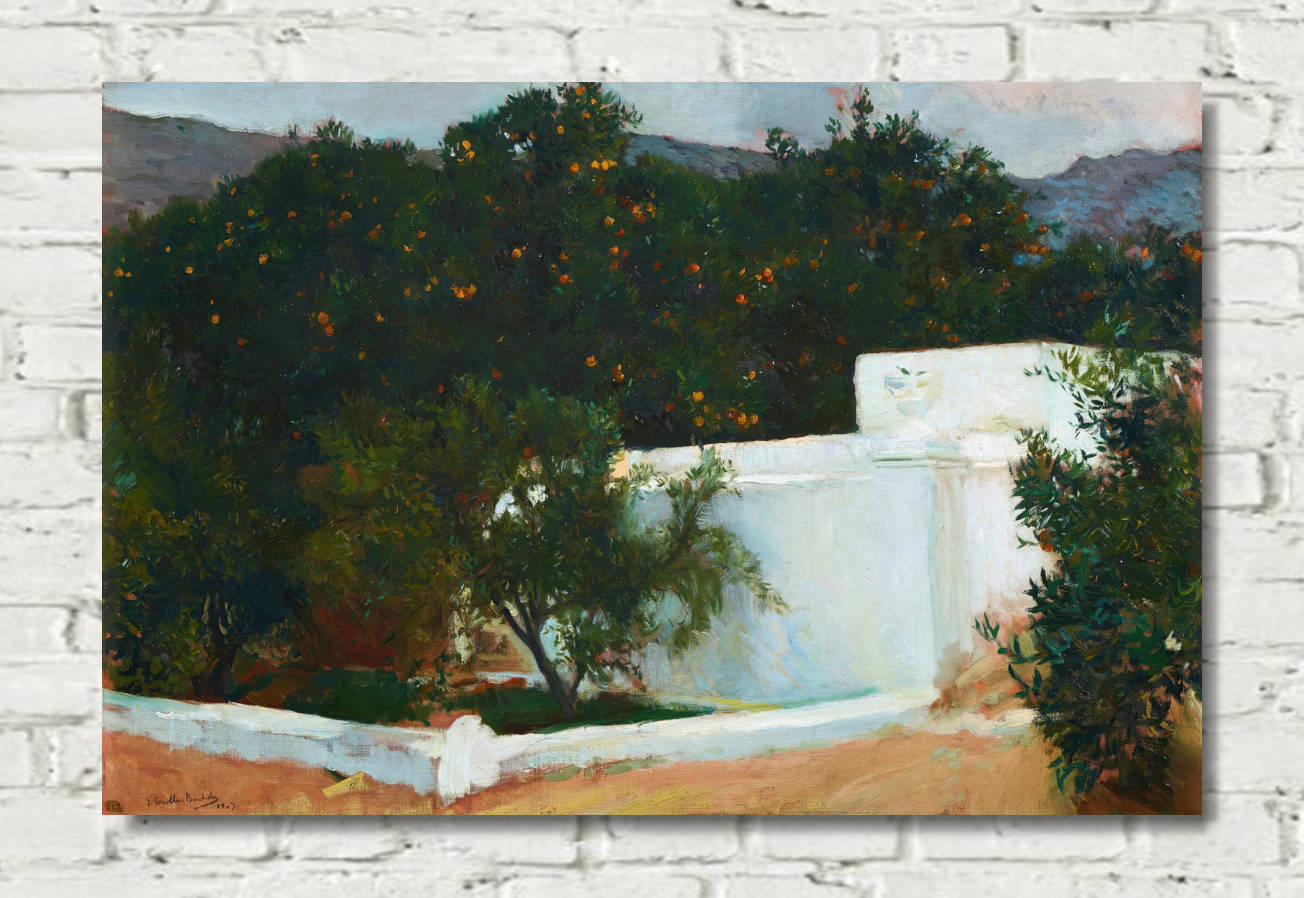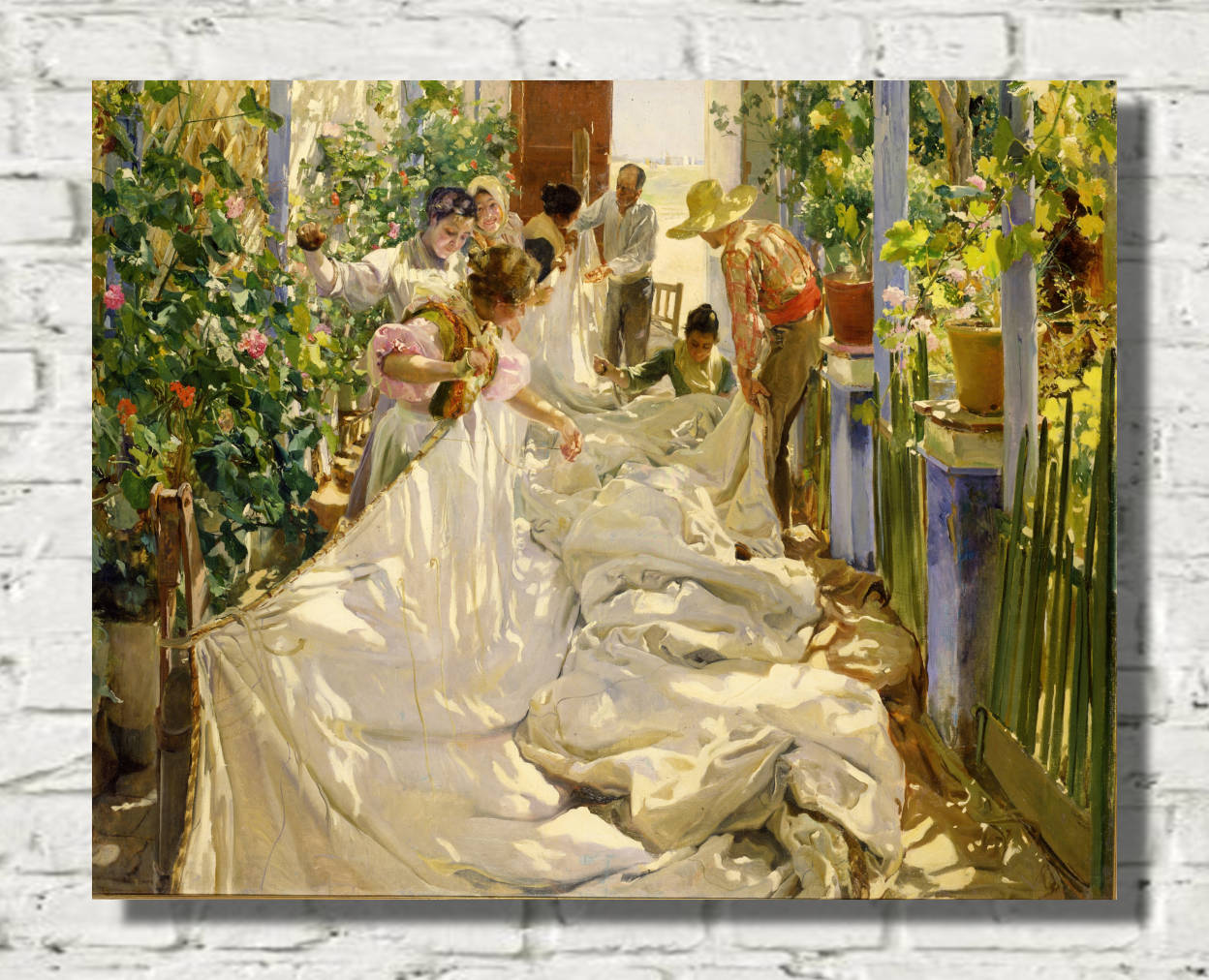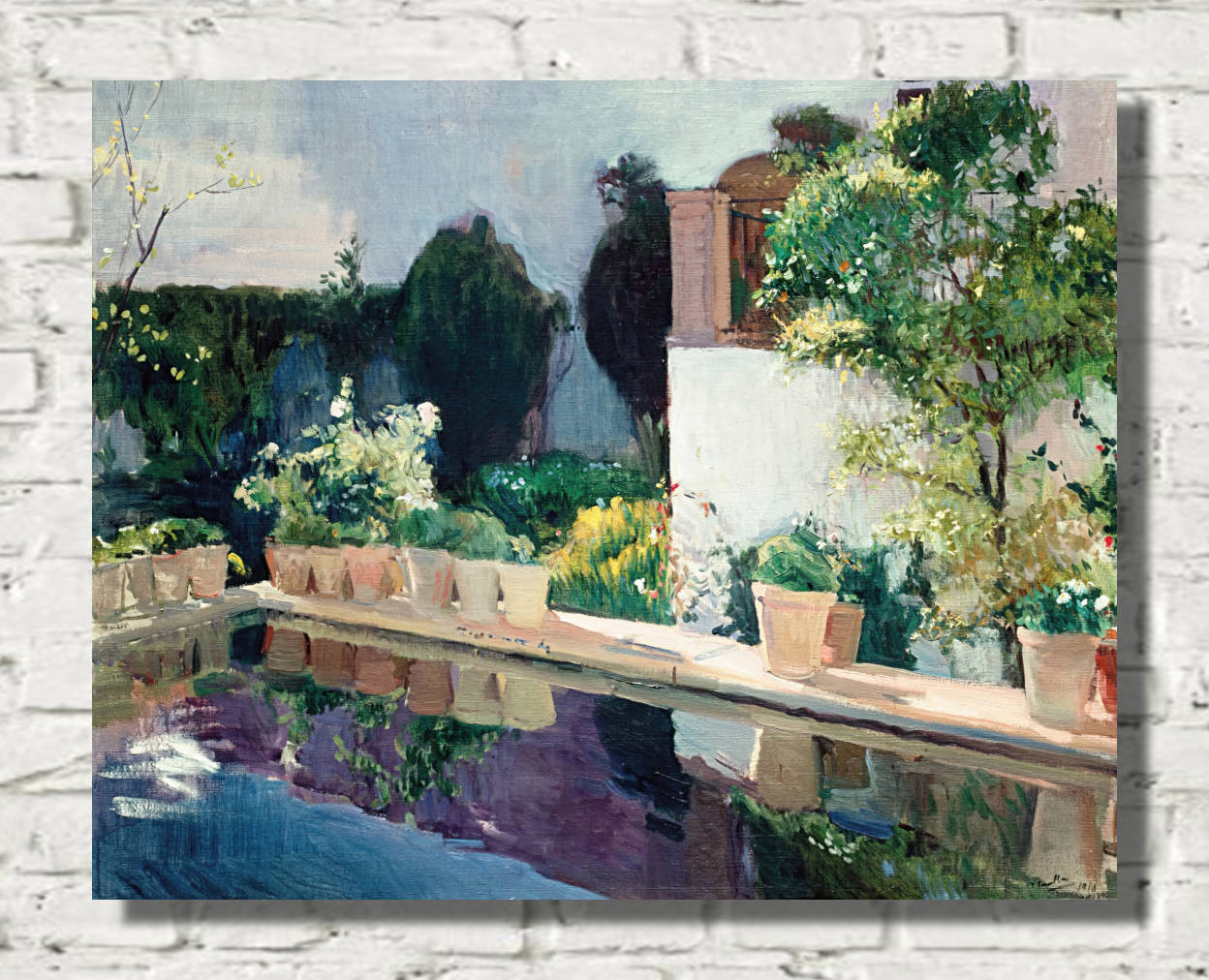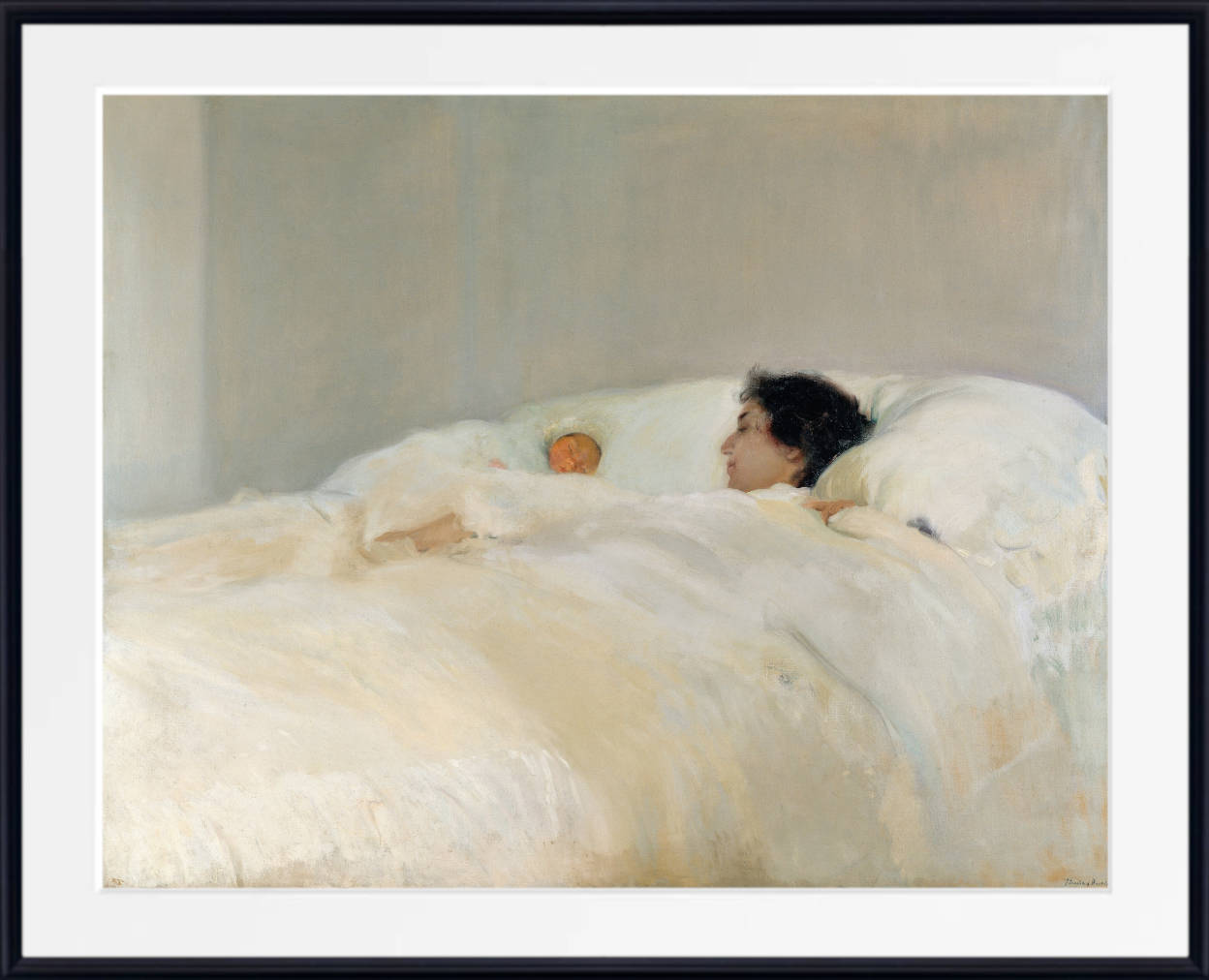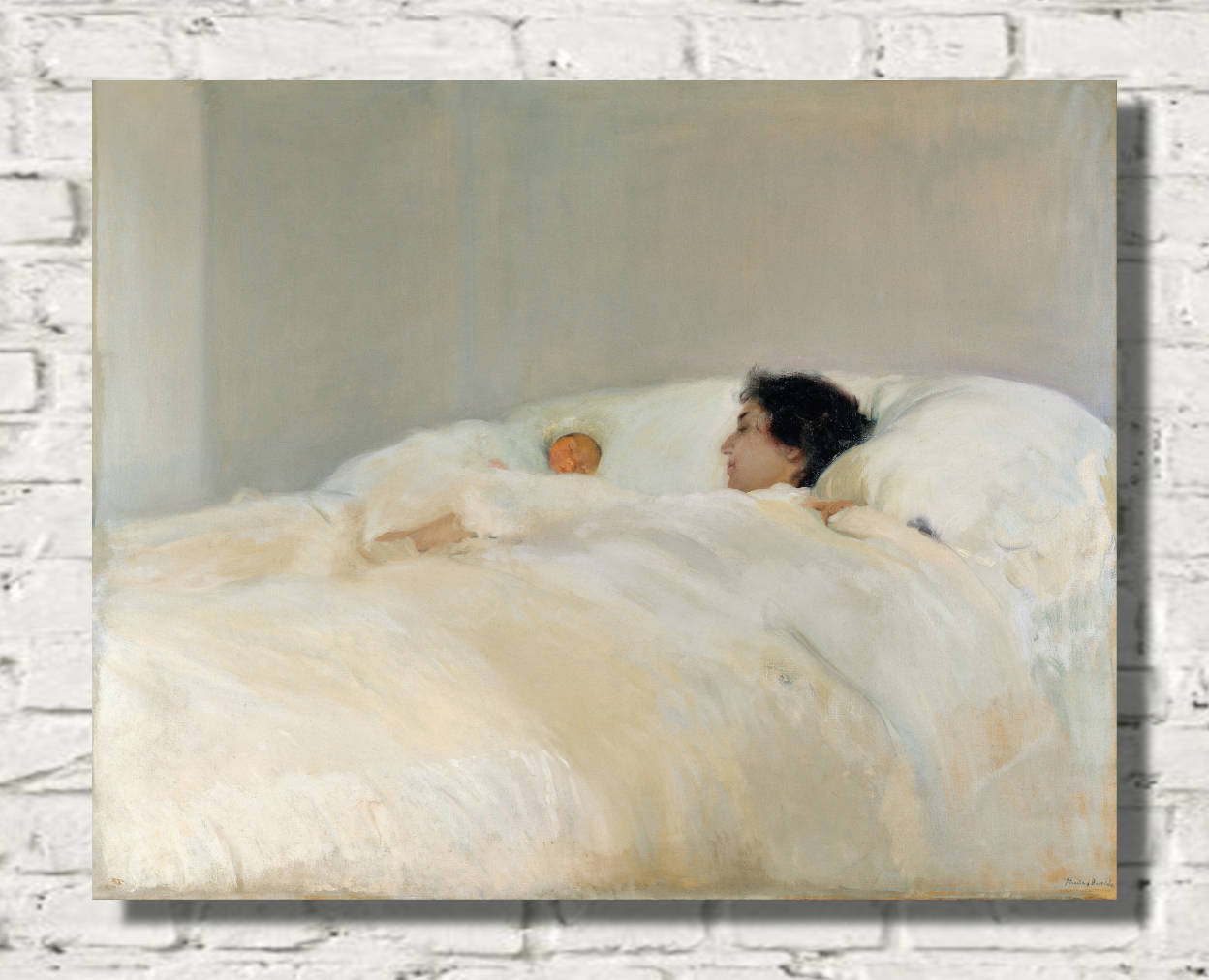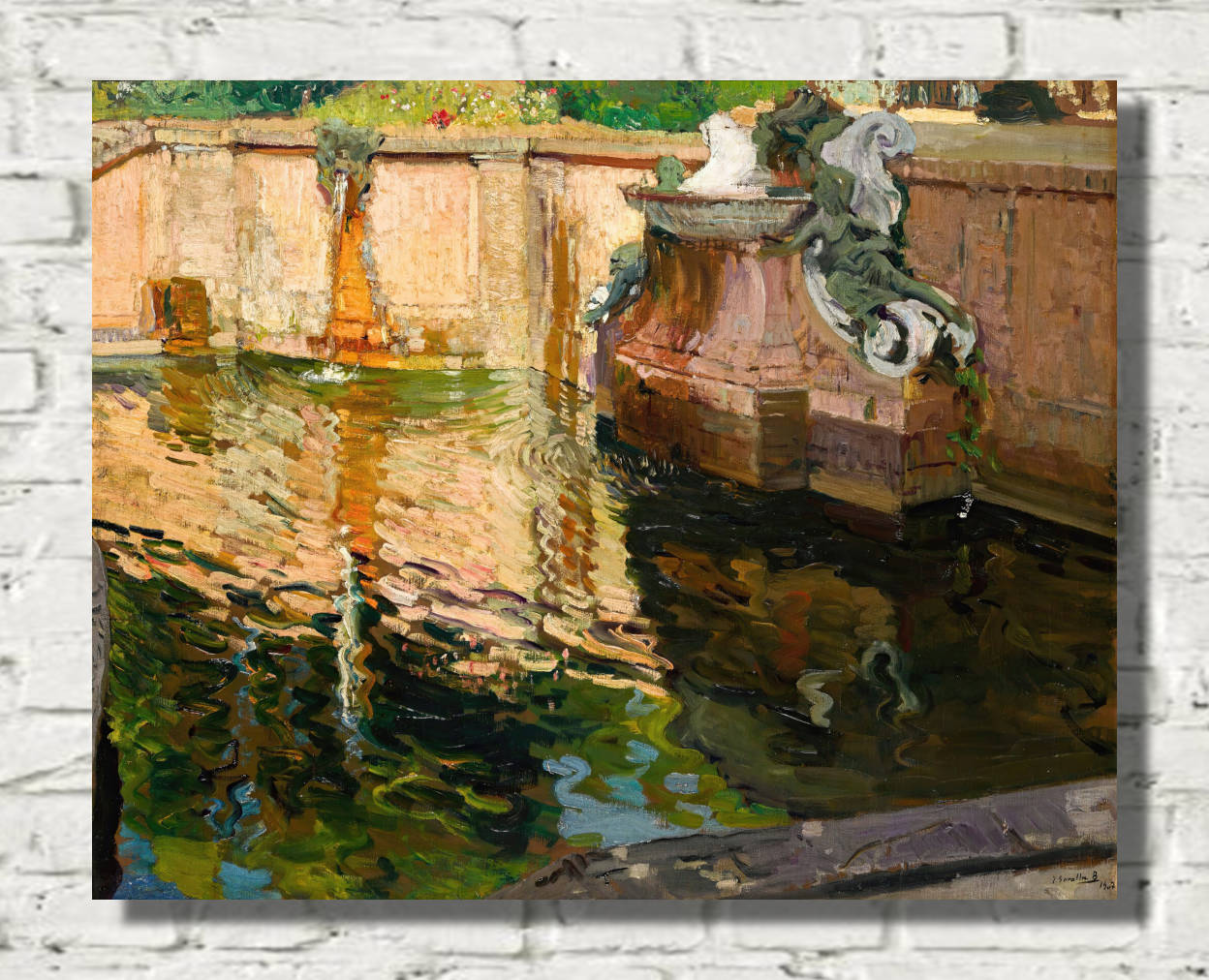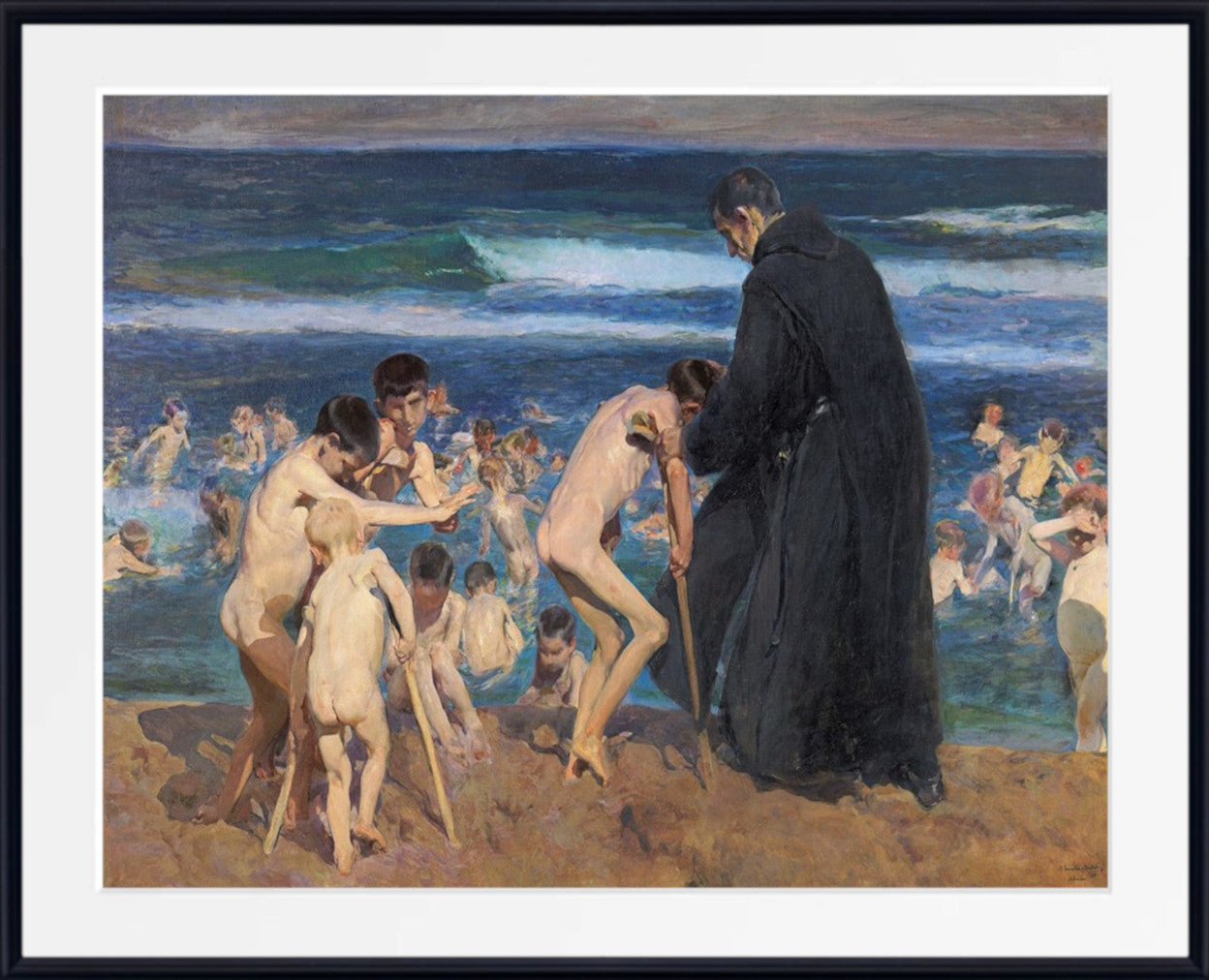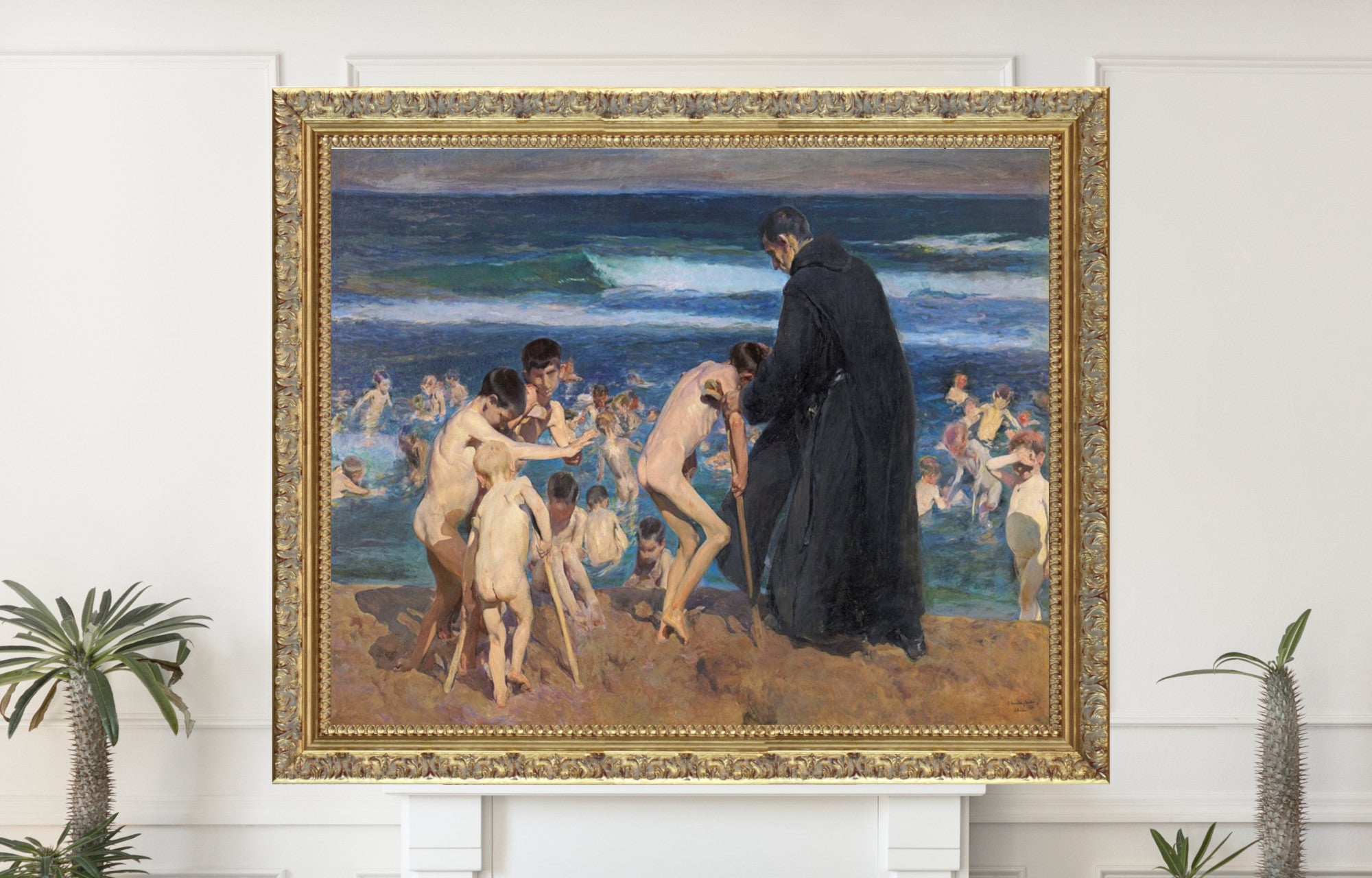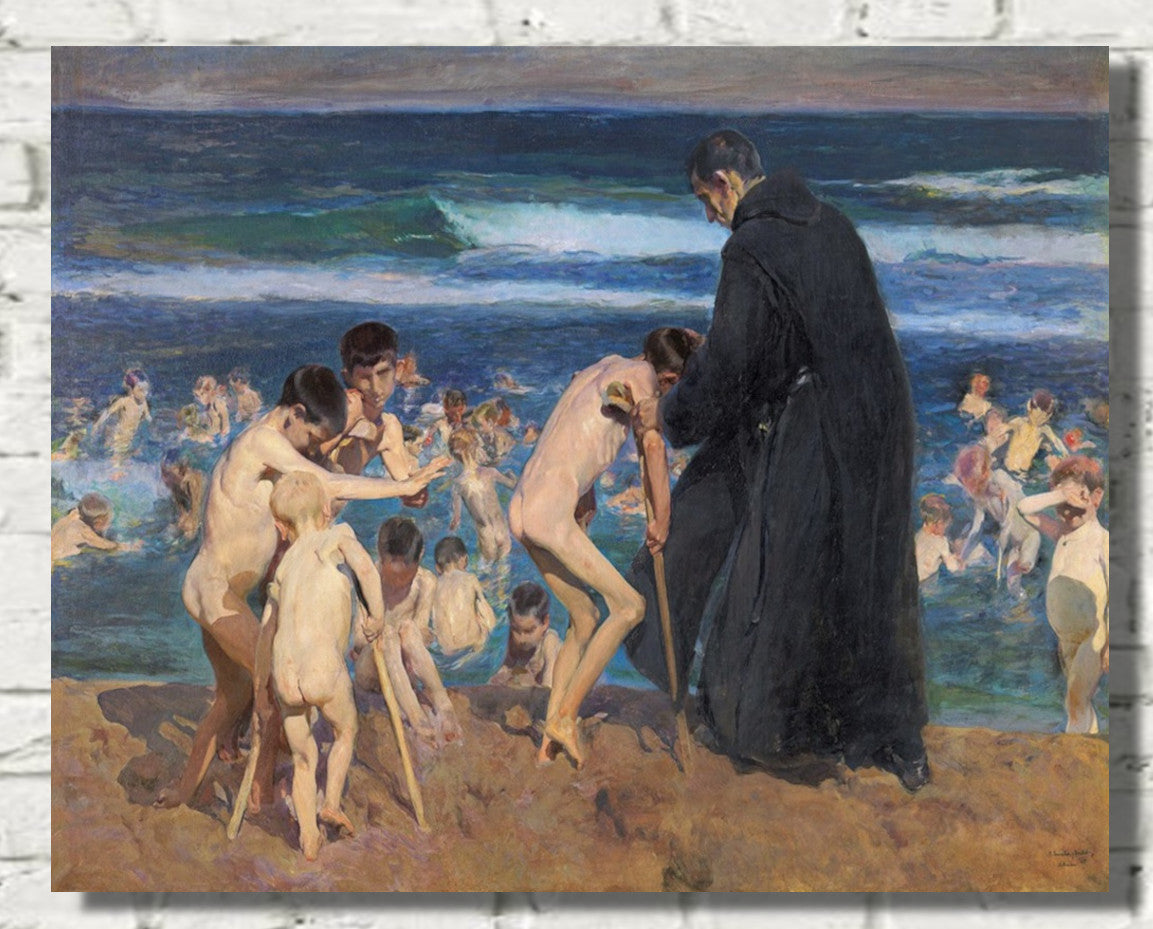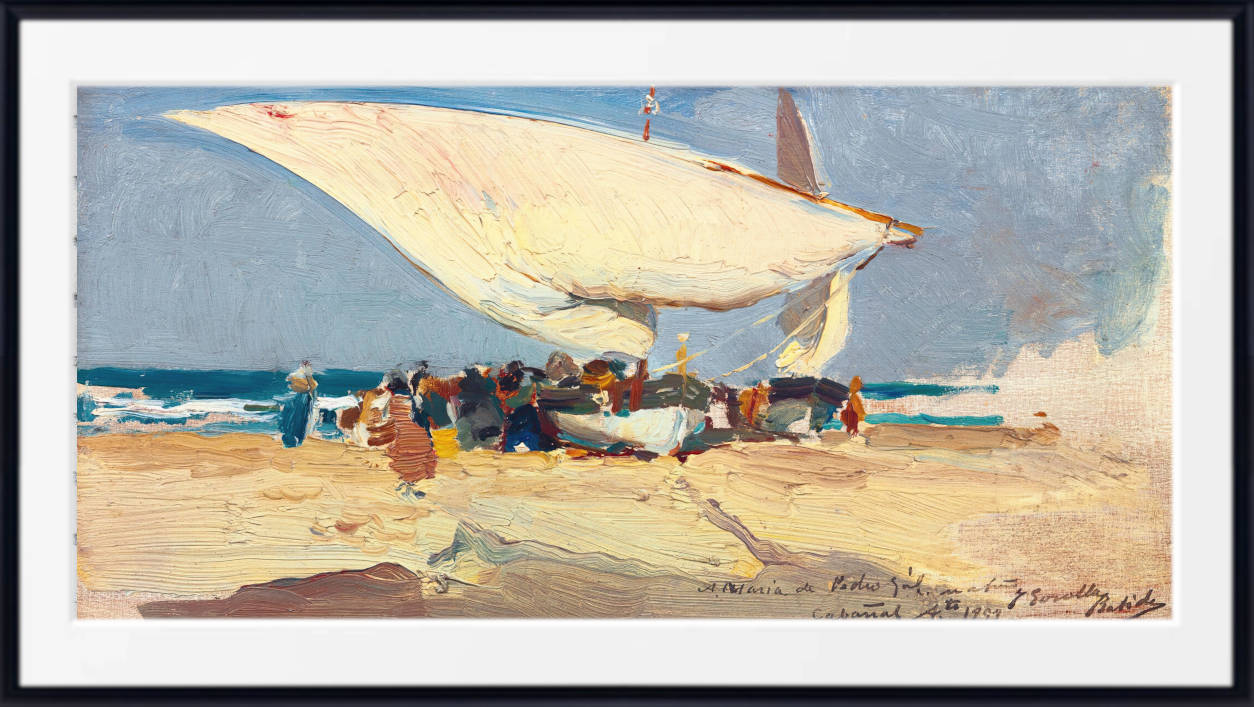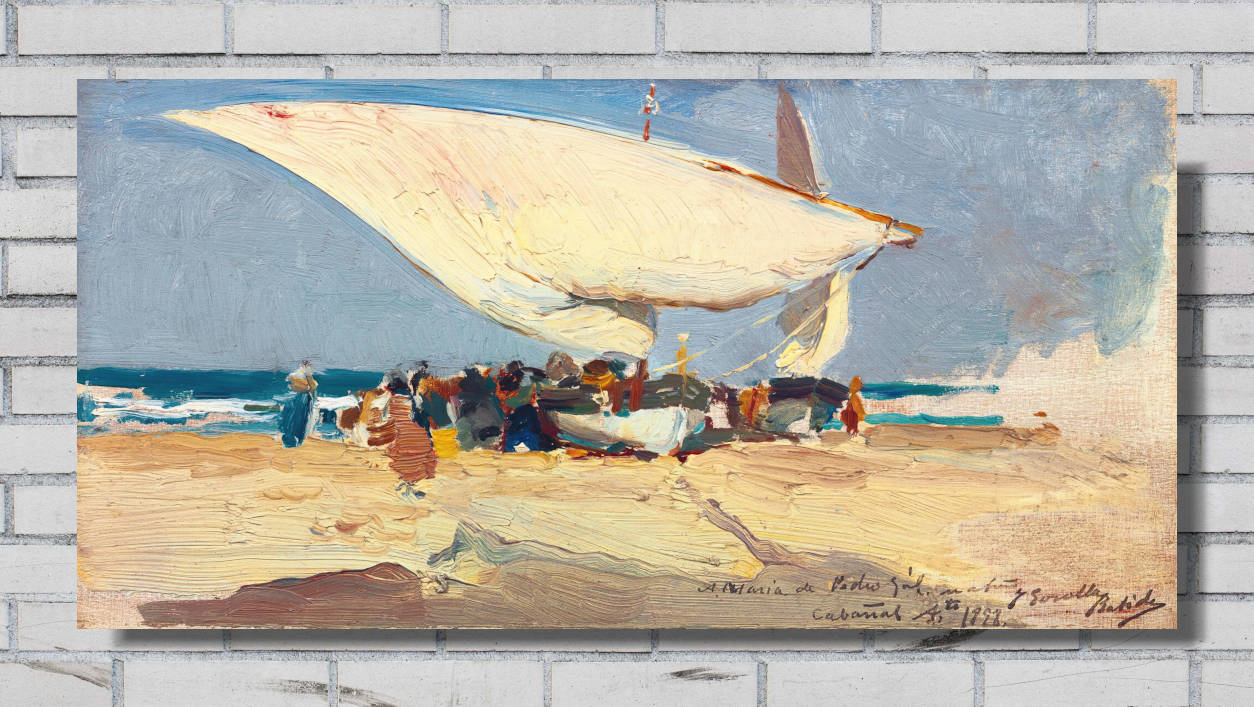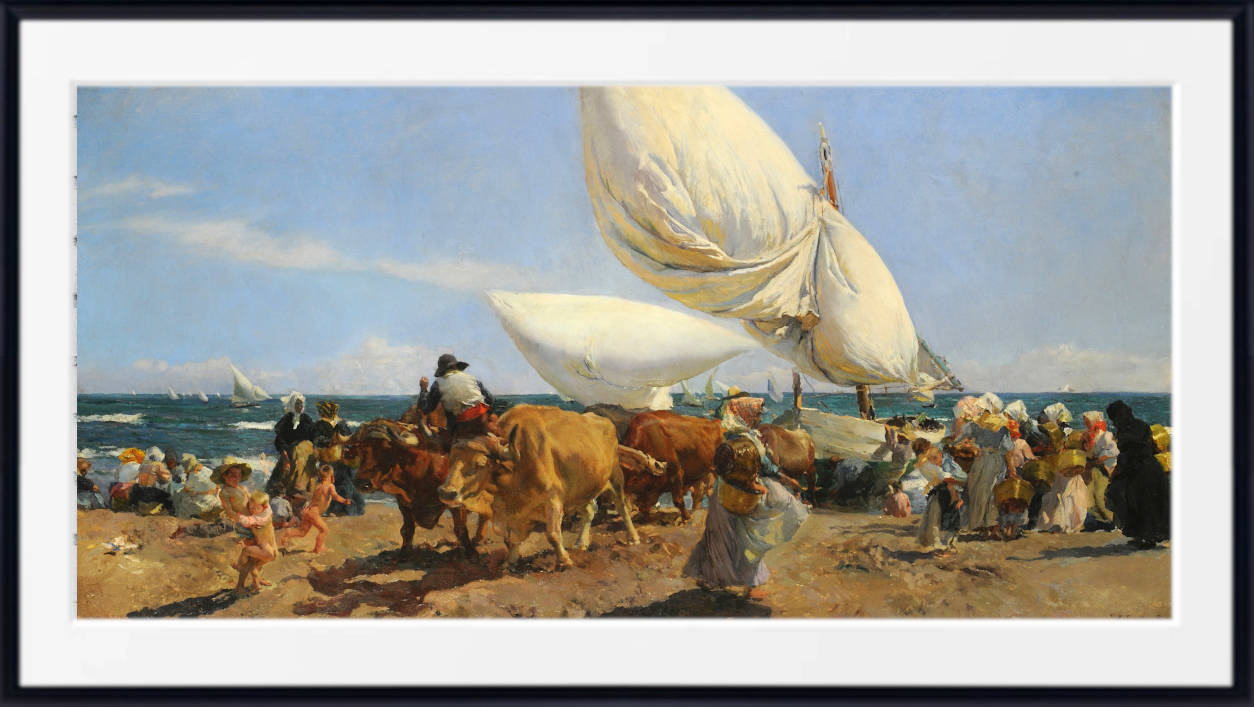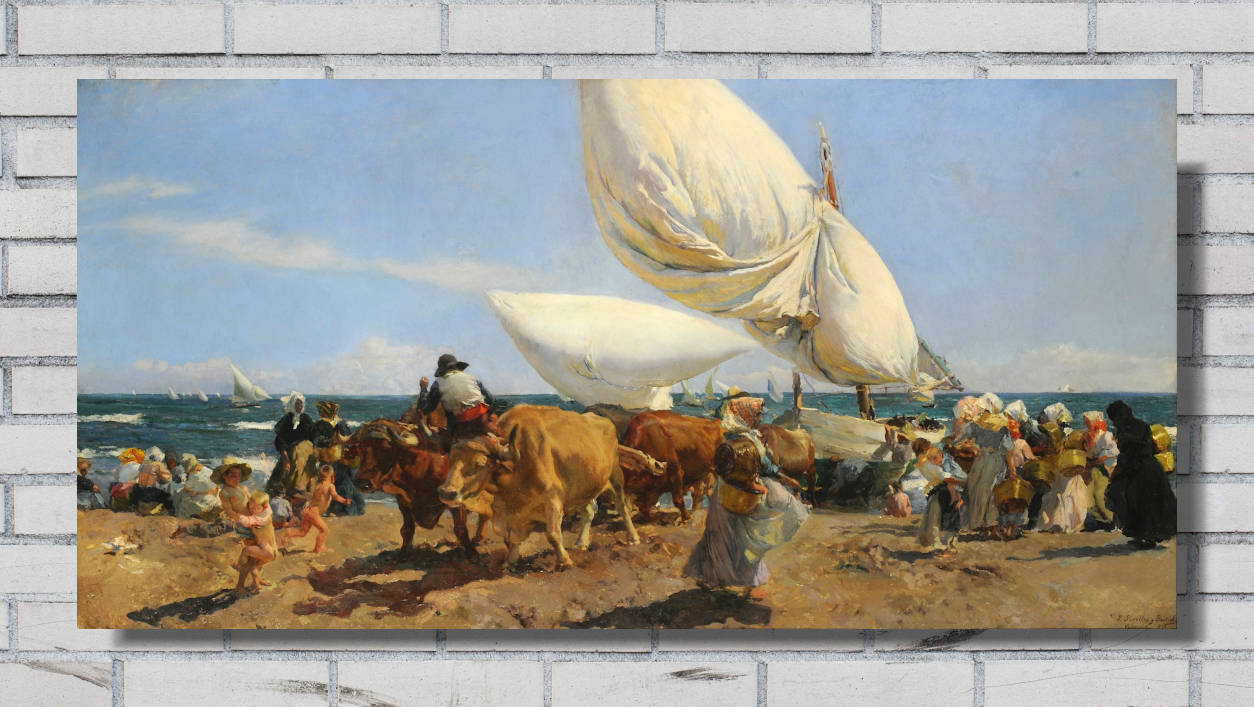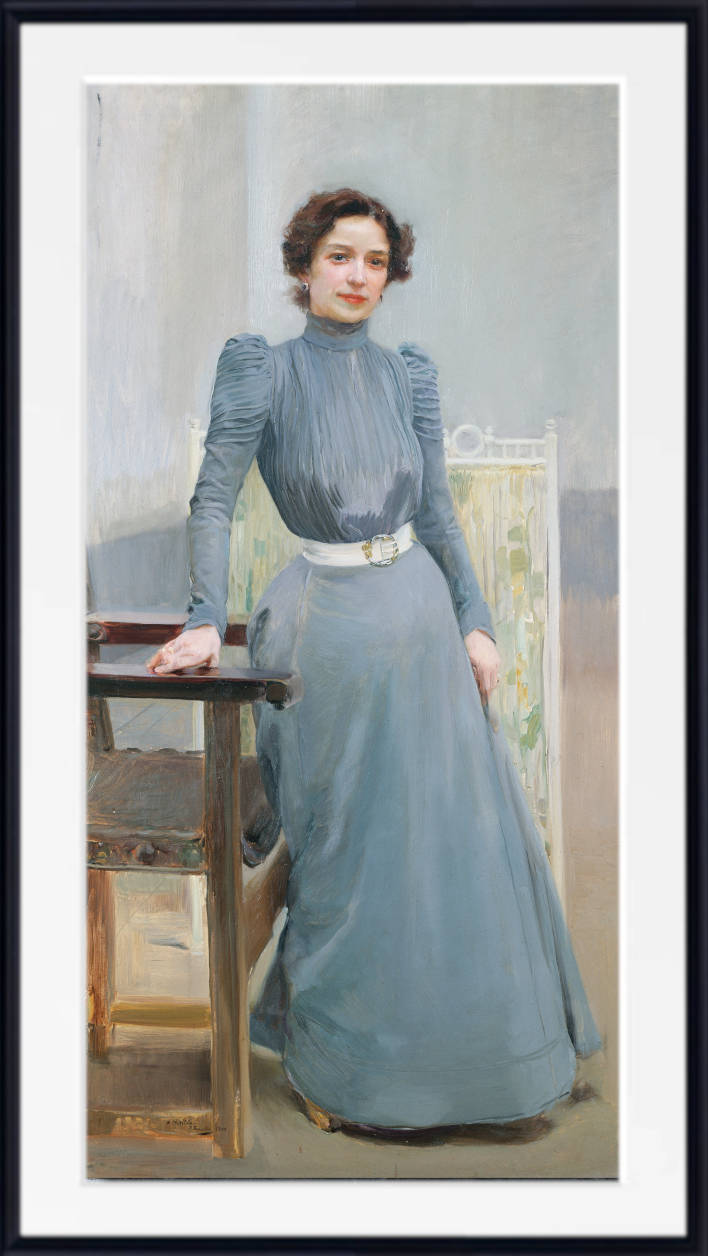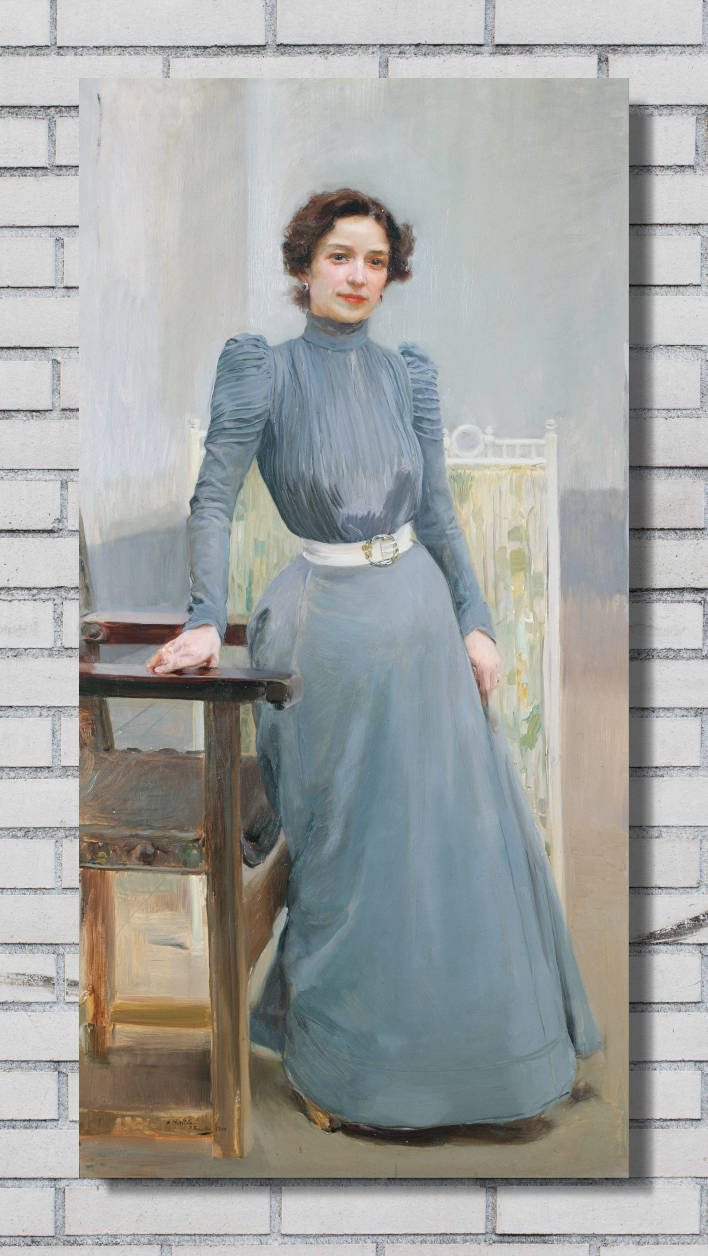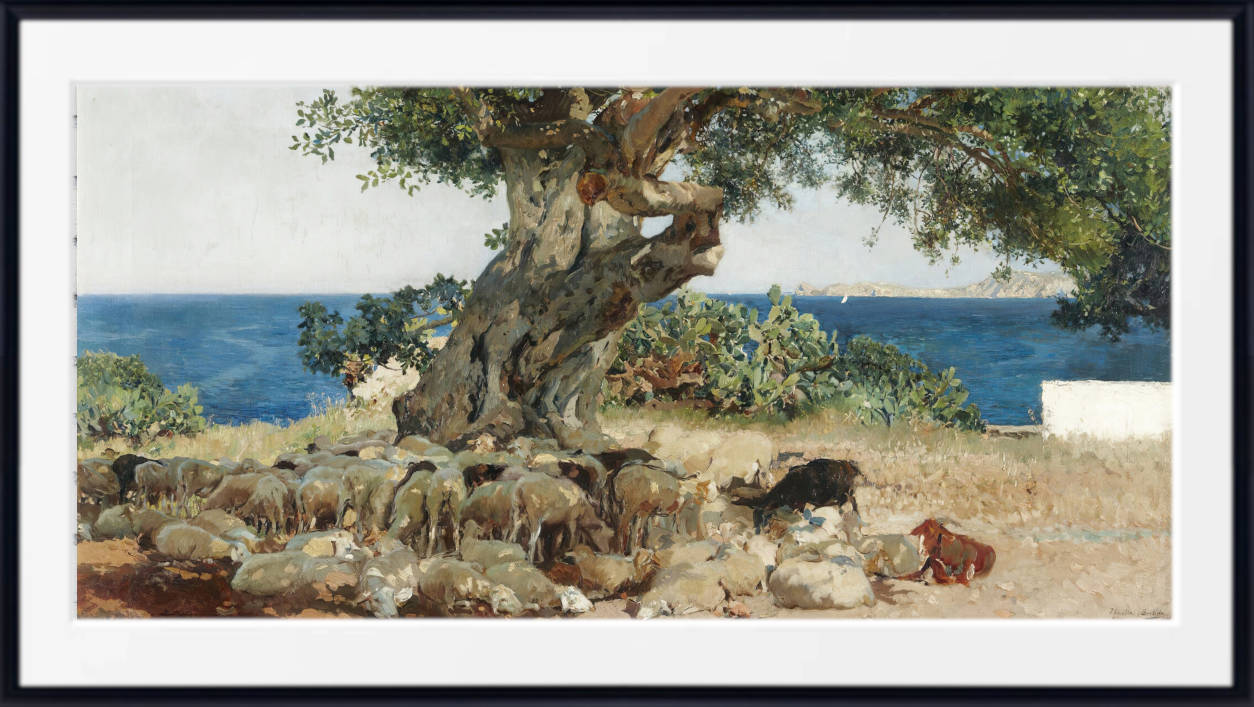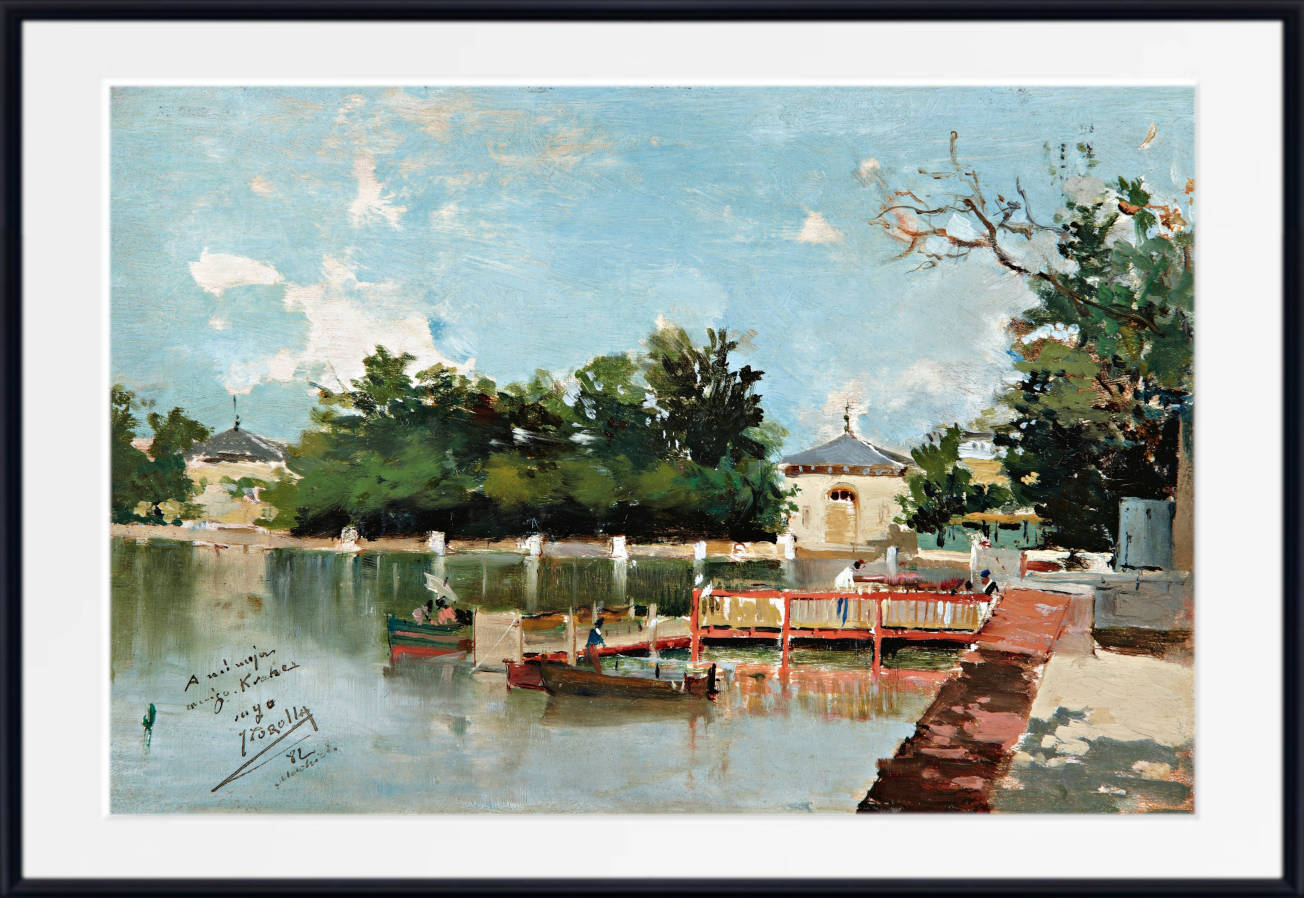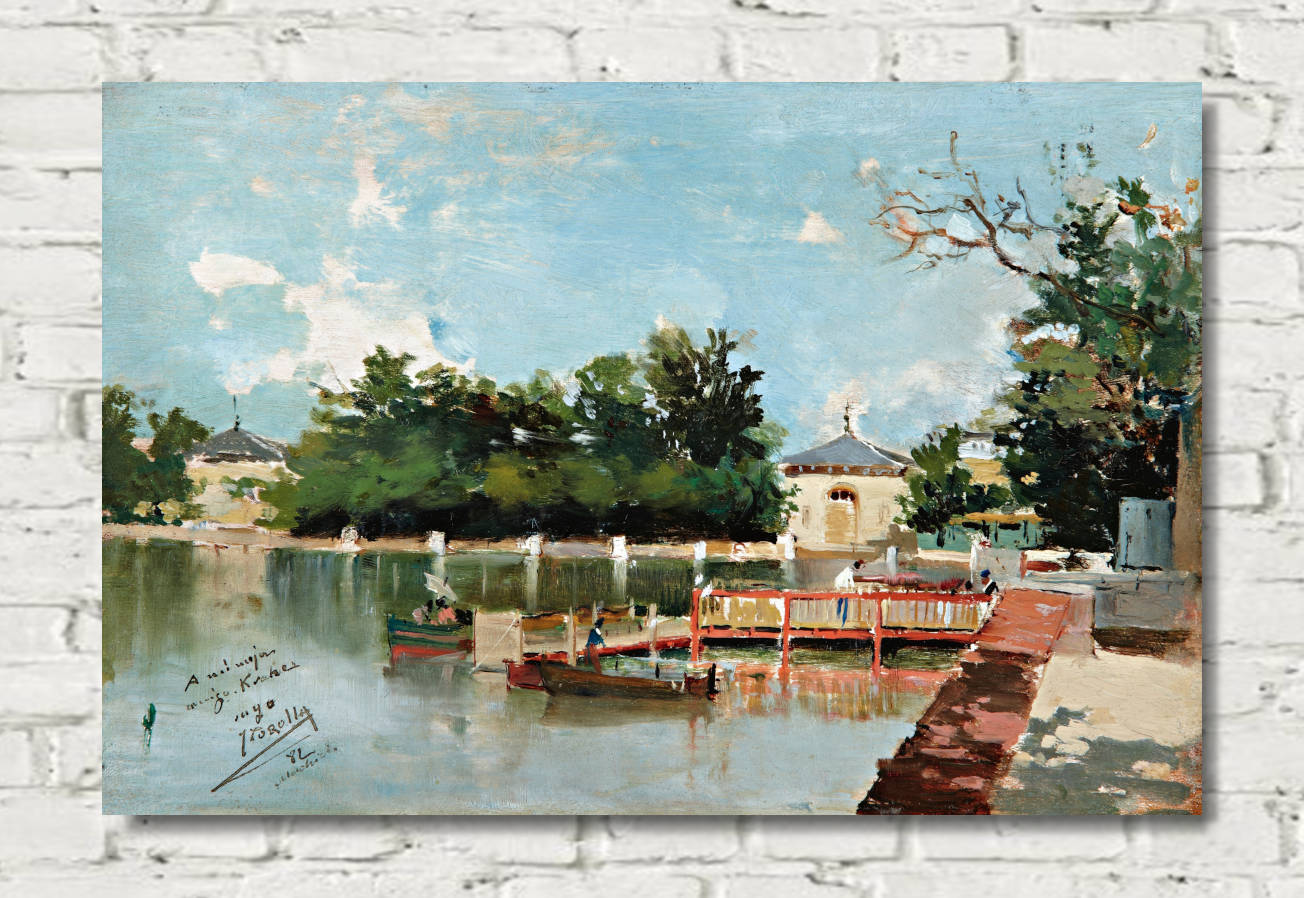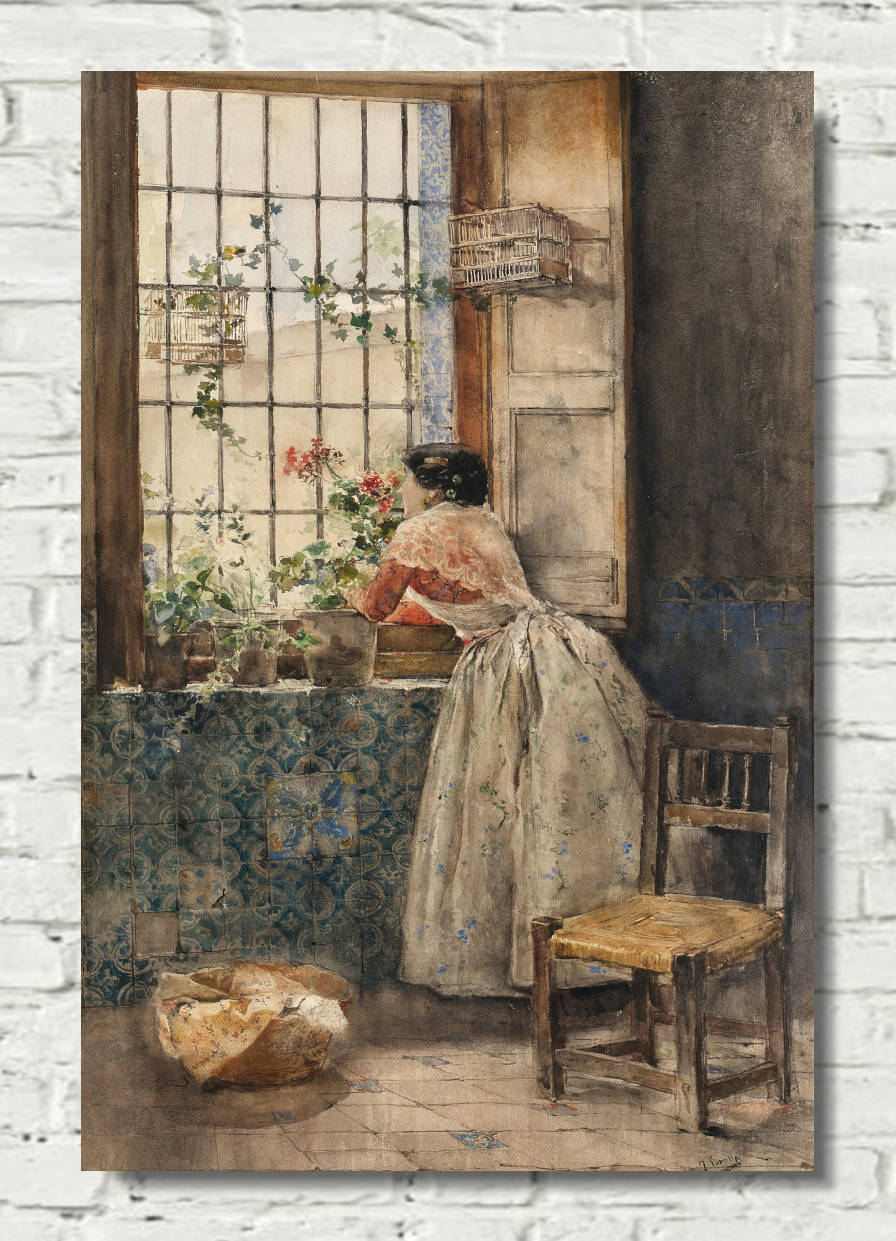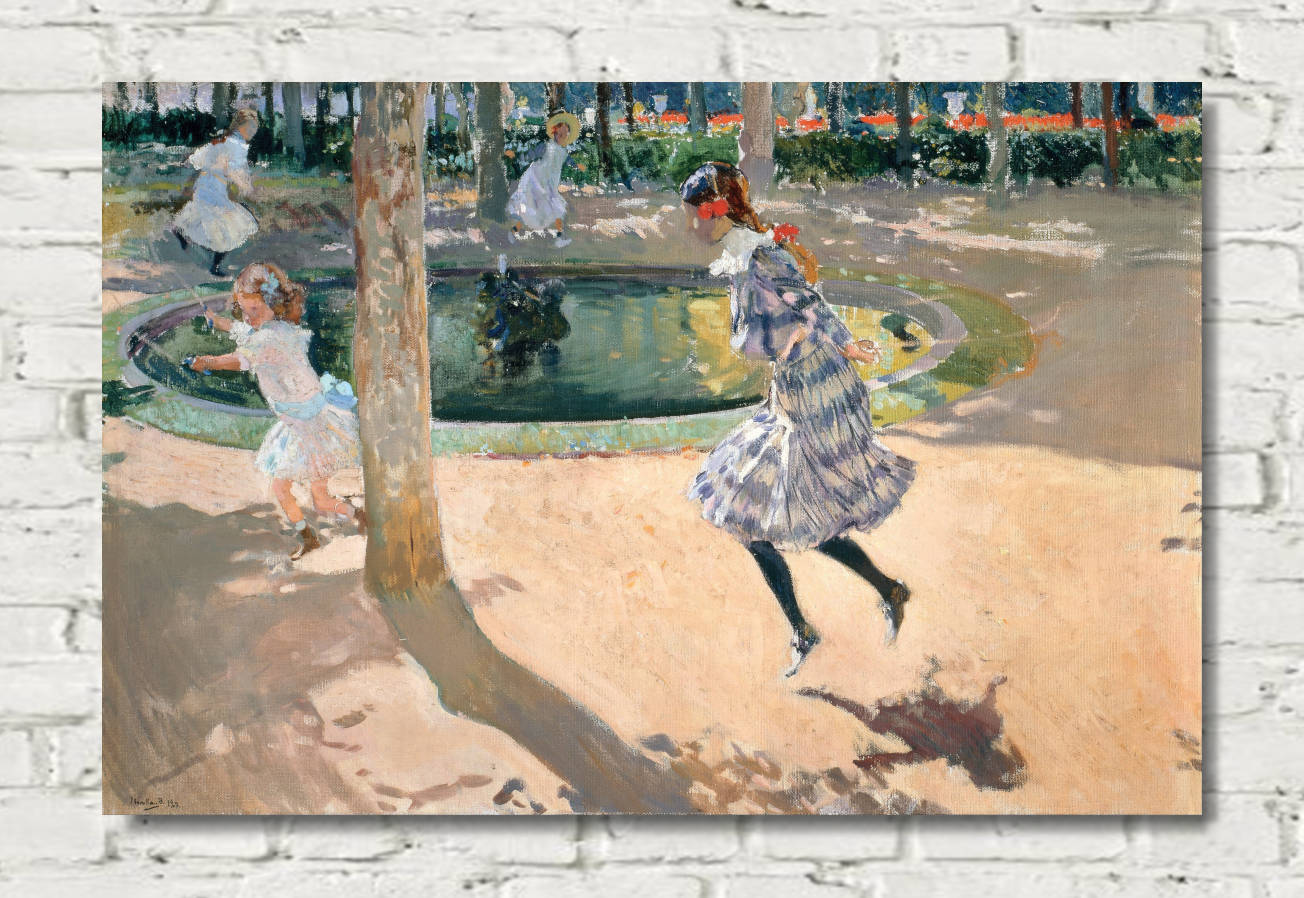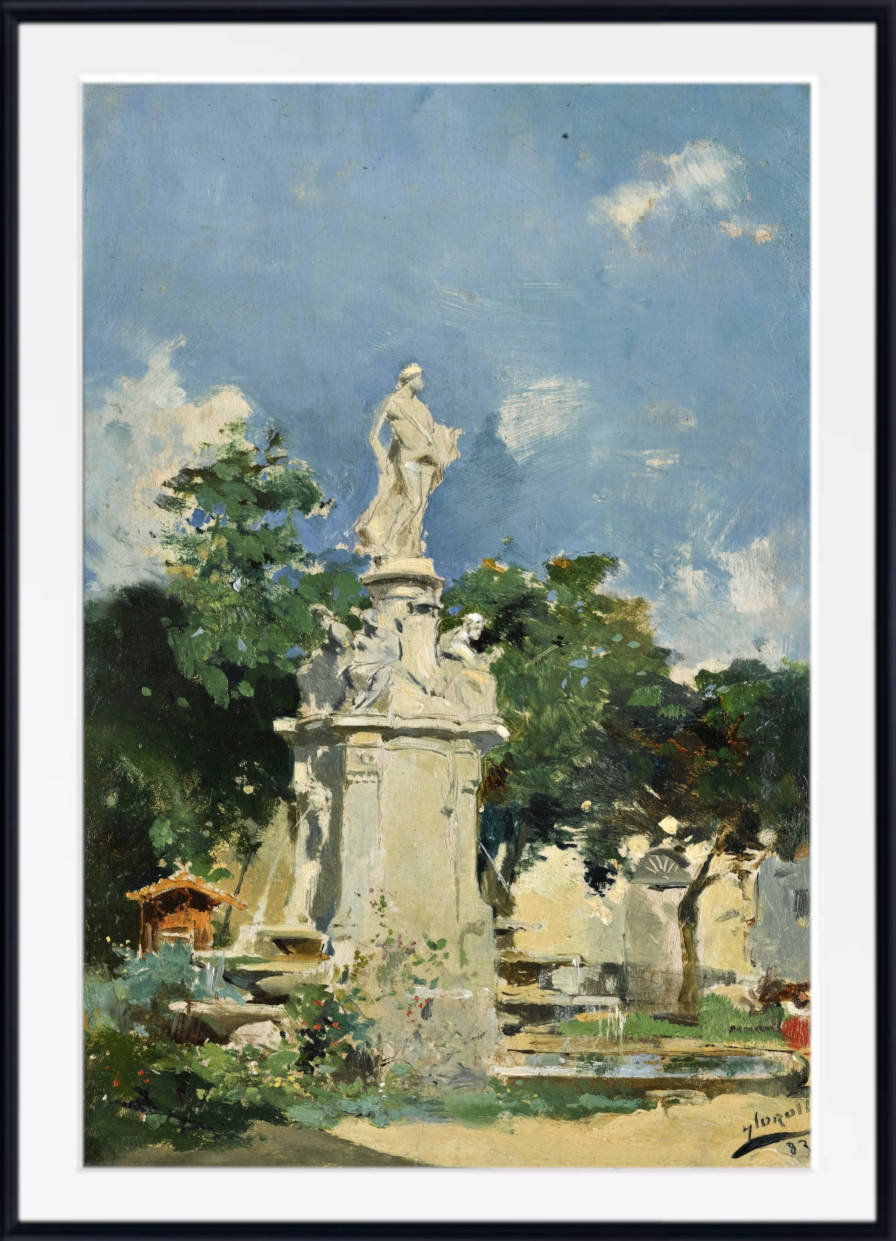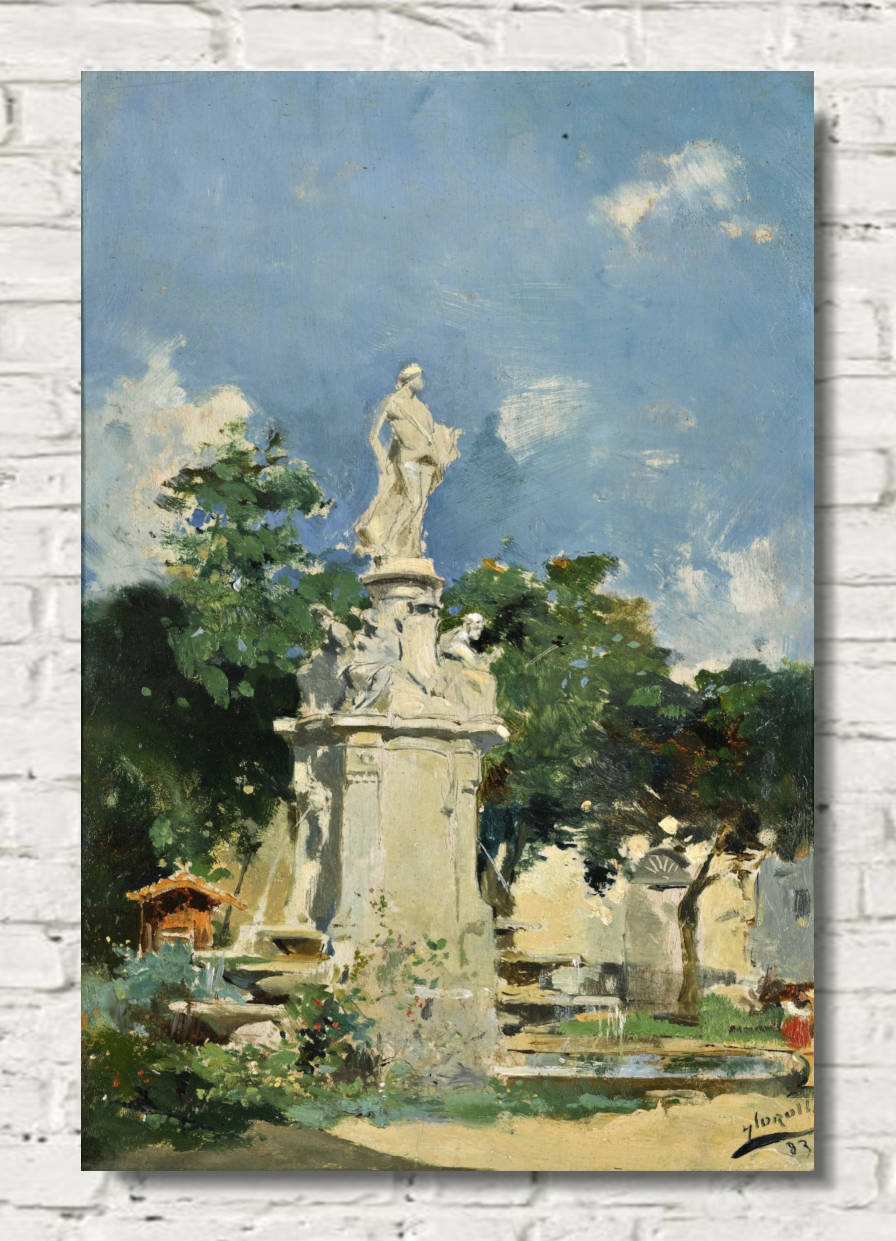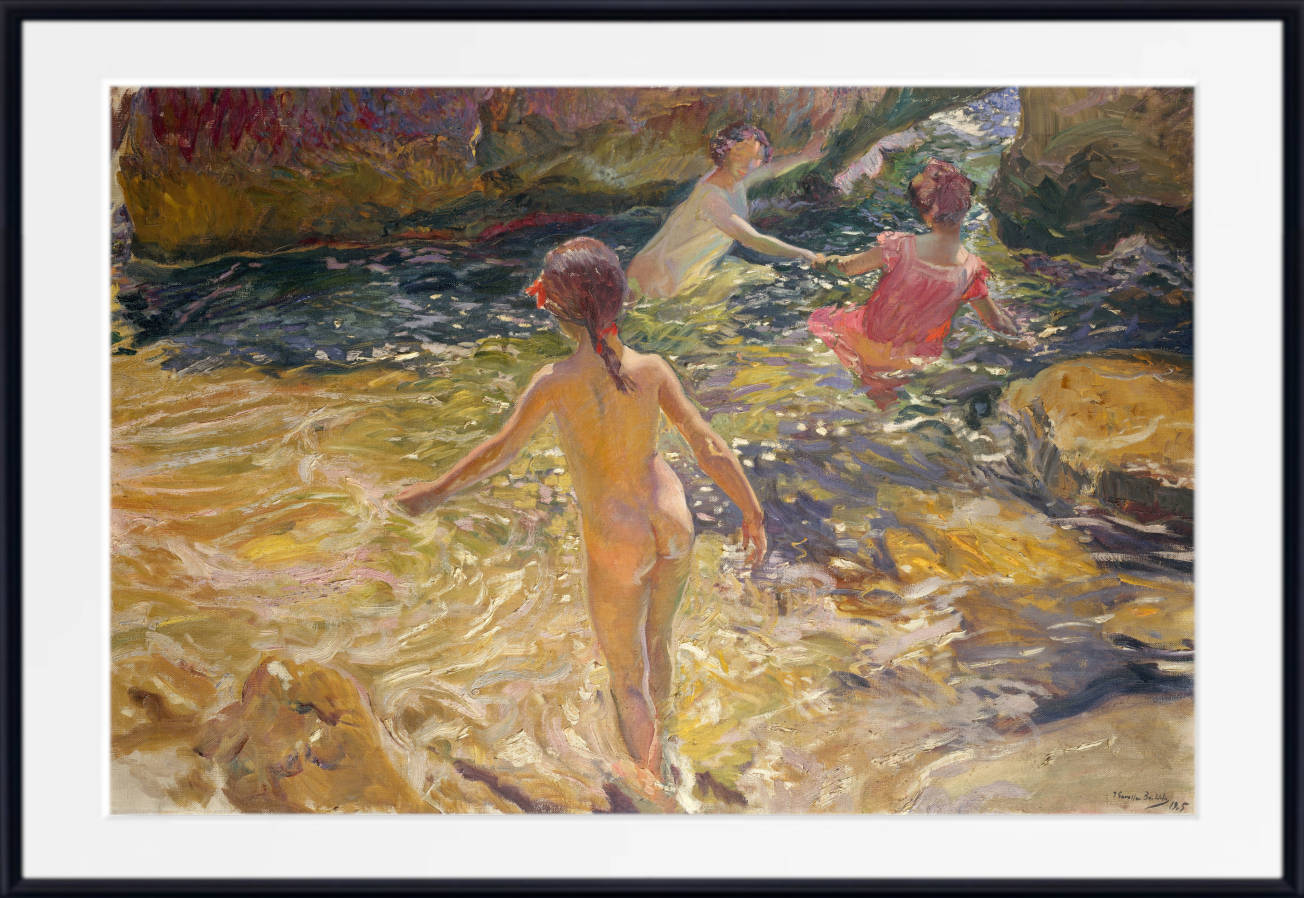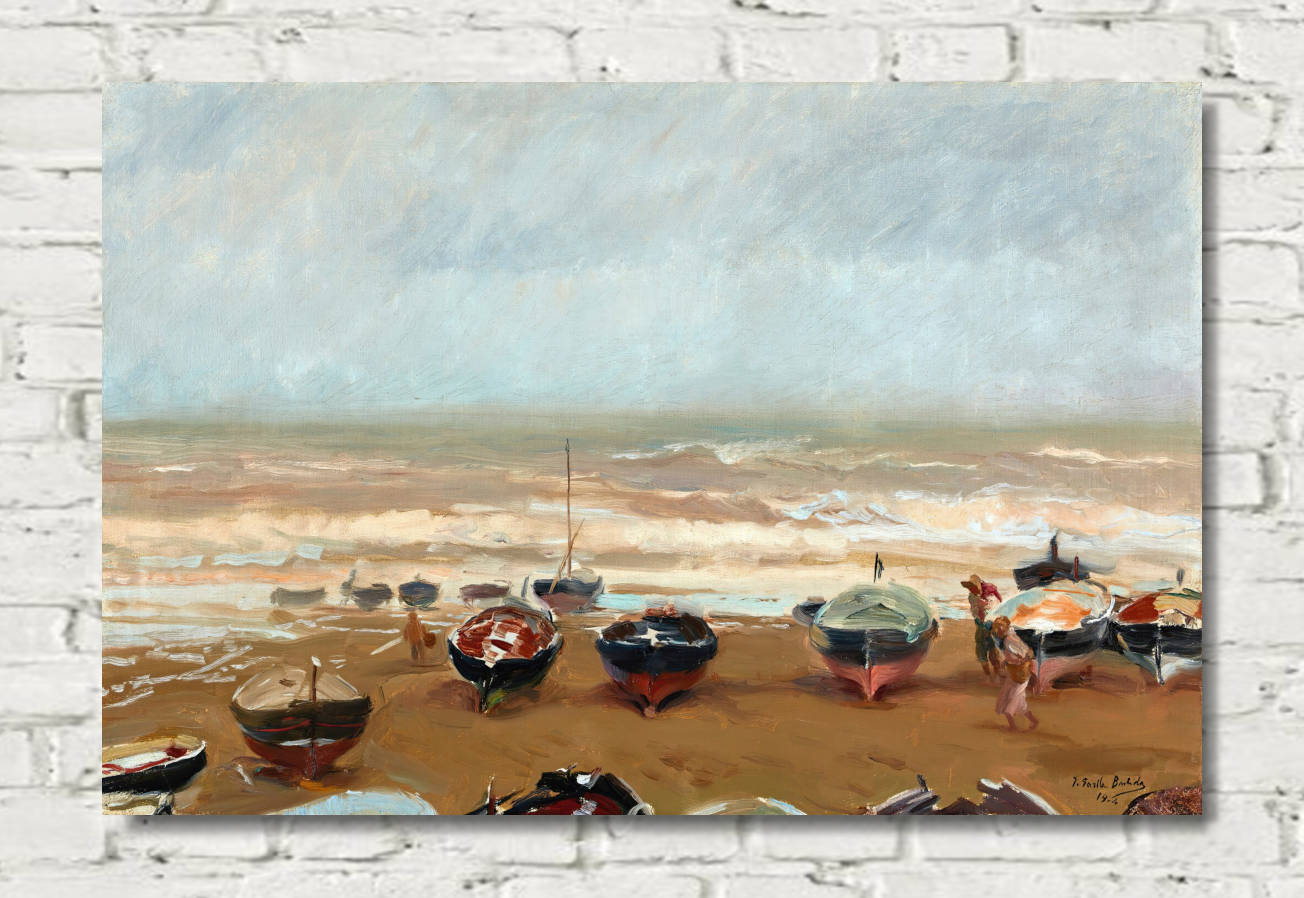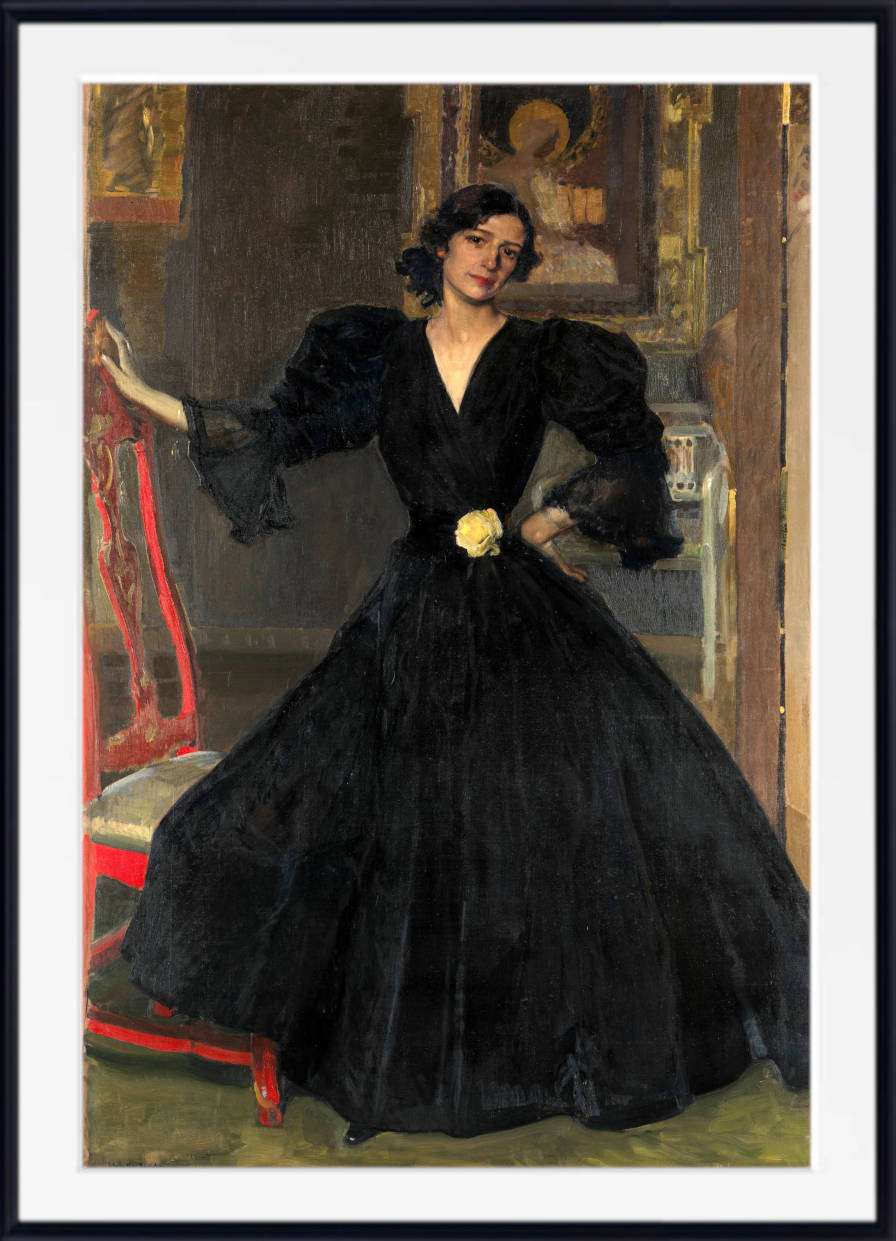Valencian Fishermen, Joaquín Sorolla
Joaquín Sorolla y Bastida (Valencian: Joaquim Sorolla i Bastida, 27 February 1863 – 10 August 1923) was a Spanish Valencian painter. Sorolla excelled in the painting of portraits, landscapes and monumental works of social and historical themes. His most typical works are characterized by a dexterous representation of the people and landscape under the bright sunlight of Spain and sunlit water.
Joaquín Sorolla - Early Life
Joaquín Sorolla was born on 27 February 1863 in Valencia, Spain. Sorolla was the eldest child born to a tradesman, also named Joaquín Sorolla, and his wife, Concepción Bastida. His sister, Concha, was born a year later. In August 1865, both children were orphaned when their parents died, possibly from cholera. They were thereafter cared for by their maternal aunt and uncle, a locksmith.
He received his initial art education at the age of 9 in his native town, and then under a succession of teachers including Cayetano Capuz, Salustiano Asenjo. At the age of eighteen he travelled to Madrid, vigorously studying master paintings in the Museo del Prado. After completing his military service, Sorolla, at age twenty-two, obtained a grant which enabled a four-year term to study painting in Rome, Italy, where he was welcomed by and found stability in the example of Francisco Pradilla, the director of the Spanish Academy in Rome. A long sojourn to Paris in 1885 provided his first exposure to modern painting; of special influence were exhibitions of Jules Bastien-Lepage and Adolph von Menzel. Back in Rome he studied with José Benlliure, Emilio Sala, and José Villegas Cordero. In 1888, Sorolla returned to Valencia to marry Clotilde García del Castillo, whom he had first met in 1879, while working in her father's studio. By 1895, they had three children together: Maria, born in 1890, Joaquín, born in 1892, and Elena, born in 1895. In 1890, they moved to Madrid, and for the next decade Sorolla's efforts as an artist were focused mainly on the production of large canvases of orientalist, mythological, historical, and social subjects, for display in salons and international exhibitions in Madrid, Paris, Venice, Munich, Berlin, and Chicago. His first striking success was achieved with Another Marguerite (1892), which was awarded a gold medal at the National Exhibition in Madrid, then first prize at the Chicago International Exhibition, where it was acquired and subsequently donated to the Washington University Museum in St. Louis, Missouri. He soon rose to general fame and became the acknowledged head of the modern Spanish school of painting. His picture The Return from Fishing (1894) was much admired at the Paris Salon and was acquired by the state for the Musée du Luxembourg. It indicated the direction of his mature output. Sorolla painted two masterpieces in 1897 linking art and science: Portrait of Dr. Simarro at the microscope and A Research. These paintings were presented at the National Exhibition of Fine Arts held in Madrid in that year and Sorolla won the Prize of Honor. Here, he presents his friend Simarro as a man of science who transmits his wisdom investigating and, in addition, it is the triumph of naturalism, as it recreates the indoor environment of the laboratory, catching the luminous atmosphere produced by the artificial reddish-yellow light of a gas burner that contrasts with the weak mauvish afternoon light that shines through the window. These paintings may be among the most outstanding world paintings of this genre.

Sad Inheritance, Joaquín Sorolla
Joaquín Sorolla - Sad Inheritance
An even greater turning point in Sorolla's career was marked by the painting and exhibition of Sad Inheritance (1899), an extremely large canvas, highly finished for public consideration. The subject was a depiction of crippled children bathing at the sea in Valencia, under the supervision of a monk. They are the victims of hereditary syphilis the title implies, perhaps. Campos has suggested that the polio epidemic that struck the land of Valencia some years earlier is present, possibly for the first time in the history of painting, through the image of two affected children. The painting earned Sorolla his greatest official recognition, the Grand Prix and a medal of honor at the Universal Exhibition in Paris in 1900, and the medal of honor at the National Exhibition in Madrid in 1901. A series of preparatory oil sketches for Sad Inheritance was painted with the greatest luminosity and bravura, and foretold an increasing interest in shimmering light and of a medium deftly handled. Sorolla thought well enough of these sketches that he presented two of them as gifts to American artists; one to John Singer Sargent, the other to William Merritt Chase. After this painting Sorolla never returned to a theme of such overt social consciousness
The Pink Robe, Joaquín Sorolla
Joaquín Sorolla - Later Years
The exhibit at the Paris Universal Exposition of 1900 won him a medal of honour and his nomination as Knight of the Legion of Honour; within the next few years Sorolla was honoured as a member of the Fine Art Academies of Paris, Lisbon, and Valencia, and as a Favourite Son of Valencia. A special exhibition of his works—figure subjects, landscapes and portraits—at the Galeries Georges Petit in Paris in 1906 eclipsed all his earlier successes and led to his appointment as Officer of the Legion of Honour. The show included nearly 500 works, early paintings as well as recent sun-drenched beach scenes, landscapes, and portraits, a productivity which amazed critics and was a financial triumph. Though subsequent large-scale exhibitions in Germany and London were greeted with more restraint, while in England in 1908 Sorolla met Archer Milton Huntington, who made him a member of The Hispanic Society of America in New York City, and invited him to exhibit there in 1909. The exhibition comprised 356 paintings, 195 of which sold. Sorolla spent five months in America and painted more than twenty portraits. Sorolla's work is often exhibited together with that of his contemporaries and friends, John Singer Sargent and Anders Zorn.
Joaquín Sorolla - Portrait Artist
Although formal portraiture was not Sorolla's genre of preference, because it tended to restrict his creative appetites and could reflect his lack of interest in his subjects, the acceptance of portrait commissions proved profitable, and the portrayal of his family was irresistible. Sometimes the influence of Velázquez was uppermost, as in My Family (1901), a reference to Las Meninas which grouped his wife and children in the foreground, the painter reflected, at work, in a distant mirror. At other times the desire to compete with his friend John Singer Sargent was evident, as in Portrait of Mrs. Ira Nelson Morris and her children (1911). A series of portraits produced in the United States in 1909, commissioned through the Hispanic Society of America, was capped by the Portrait of Mr. Taft, President of the United States, This portrait, which was painted at the White House, is on permanent display at the Taft Museum of Art in Cincinnati, Ohio.
The appearance of sunlight could be counted on to rouse his interest, and it was outdoors where he found his ideal portrait settings. Thus, not only did his daughter pose standing in a sun-dappled landscape for María at La Granja (1907), but so did Spanish royalty, for the Portrait of King Alfonso XIII in a Hussar's Uniform (1907). For Portrait of Mr. Louis Comfort Tiffany (1911), the American artist posed seated at his easel in his Long Island garden, surrounded by extravagant flowers. The conceit reaches its high point in My Wife and Daughters in the Garden (1910, see gallery below), in which the idea of traditional portraiture gives way to the sheer fluid delight of a painting constructed with thick passages of color, Sorolla's love of family and sunlight merged.

Joaquín Sorolla paintings in the Hispanic Society of America

Children In The Sea, Valencia Beach, Joaquín Sorolla
Joaquín Sorolla - Provinces of Spain
Early in 1911, Sorolla visited the United States for a second time, and exhibited 152 new paintings at the Saint Louis Art Museum and 161 at the Art Institute of Chicago a few weeks later. Later that year Sorolla met Archie Huntington in Paris and signed a contract to paint a series of oils on life in Spain. These 14 magnificent murals, installed to this day in the Hispanic Society of America building in Manhattan, range from 12 to 14 feet in height, and total 227 feet in length. The major commission of his career, it dominated the later years of Sorolla's life. Huntington had envisioned the work depicting a history of Spain, but the painter preferred the less specific Vision of Spain, eventually opting for a representation of the regions of the Iberian Peninsula, and calling it The Provinces of Spain. Despite the immensity of the canvases, Sorolla painted all but one en plein air, and travelled to the specific locales to paint them: Navarre, Aragon, Catalonia, Valencia, Elche, Seville, Andalusia, Extremadura, Galicia, Guipuzcoa, Castile, Leon, and Ayamonte, at each site painting models posed in local costume. Each mural celebrated the landscape and culture of its region, panoramas composed of throngs of laborers and locals. By 1917 he was, by his own admission, exhausted. He completed the final panel by July 1919. Sorolla suffered a stroke in 1920, while painting a portrait in his garden in Madrid. Paralysed for over three years, he died on 10 August 1923. He is buried in the Cementeri de Valencia, Spain. The Sorolla Room, housing the Provinces of Spain at the Hispanic Society of America, opened to the public in 1926. The room closed for remodeling in 2008, and the murals toured museums in Spain for the first time. The Sorolla Room reopened in 2010, with the murals on permanent display.

Children On The Beach, Valencia, Joaquín Sorolla
Joaquín Sorolla - Legacy
Sorolla's influence on some other Spanish painters, such as Alberto Pla y Rubio and Julio Romero de Torres, was so noted that they are described as "sorollista." After his death, Sorolla's widow, Clotilde García del Castillo, left many of his paintings to the Spanish public. The paintings eventually formed the collection that is now known as the Museo Sorolla, which was the artist's house in Madrid. The museum opened in 1932. Sorolla's work is represented in museums throughout Spain, Europe, America, and in many private collections in Europe and America. In 1933, J. Paul Getty purchased ten Impressionist beach scenes made by Sorolla, several of which are now housed in the J. Paul Getty Museum. In 1960, Sorolla, el pintor de la luz, a short documentary written and directed by Manuel Domínguez was presented at the Cannes Film Festival. The Spanish National Dance Company honored the painter's The Provinces of Spain by producing a ballet Sorolla based on the paintings. The high-speed railway station in Valencia is named after Sorolla.
Joaquín Sorolla - The Complete Works
| Title | Date | Current location |
|---|---|---|
| Cabeza de niño | 1870 | Museo Soumaya |
| Seelandschaft | 1880 | |
| Harbour | 1881 | Sorolla Museum |
| Cabeza de mujer con mantilla blanca | 1882 | Museo del Prado |
| Study of Christ | 1883 | |
| The palleter's cry | 1884 | Provincial Council of Valencia |
| El Dos de Maig Defensa del Parque de Artilleria de Monteleón, en Madrid, | 1884 | Biblioteca Museu Víctor Balaguer |
| Dos de mayo | 1884 | Museo del Prado |
| Virgin Mary | 1885 | Museu de Belles Arts de València |
| Juan del Castillo | 1885 | Hispanic Society of America |
| A Member of the Garcia-Castillo Family | 1885 | Hispanic Society of America |
| The death of Pedro Velarde y Santillán | 1886 | Museo del Prado |
| The Nereids | 1886 | |
| Rafael Altamira y Crevea | 1886 | Museo del Prado |
| Study of a Moorish Gentleman | 1886 | Mildred Lane Kemper Art Museum |
| Padre Jofré defending a crazy | 1887 | Palau de la Generalitat Valenciana |
| Napolitana | 1887 | Museum of Fine Arts of Córdoba |
| Studie zu Booten | 1887 | National Museum of Fine Arts of Cuba |
| Portrait of the Painter Francesco Santoro, Rome | 1887 | Minneapolis Institute of Art |
| Santa en oración | 1888 | Museo del Prado |
| Contadina de Asís | 1888 | Sorolla Museum |
| Clotilde at the Window | 1888 | |
| Os Guitarristas, hábitos valencianos | 1889 | Sorolla Museum |
| Llegada de la pesca | 1889 | Museo Nacional Centro de Arte Reina Sofía |
| Clotilde García del Castillo | 1890 | Sorolla Museum |
| Melonenverkäufer | 1890 | Carmen Thyssen Museum |
| Peeling Potatoes | 1891 | |
| Portrait of the Poet José Joaquín Herrero y Sánchez | 1891 | Mildred Lane Kemper Art Museum |
| Portrait of Agustín Otermín | 1892 | Fundación Banco Santander |
| Jaime García Banús | 1892 | Museo del Prado |
| El pintor Juan Espina y Capo | 1892 | Museo del Prado |
| ¡Otra Margarita! | 1892 | Mildred Lane Kemper Art Museum |
| Kissing the Relic | 1893 | Bilbao Fine Arts Museum |
| Valencian Scene | 1893 | |
| En la sacristia | 1893 | National Museum of Fine Arts |
| Portrait of Benito Pérez Galdós | 1894 | Casa-Museo Pérez Galdós |
| Fishing boats on the beach, Valencia | 1894 | |
| White slave trade | 1894 | Sorolla Museum |
| And They Still Say Fish is Expensive! | 1894 | Museo del Prado |
| The Return from Fishing | 1894 | Musée d'Orsay |
| Sea Wolf | 1894 | National Museum of Fine Arts |
| Valencian Fisherman | 1895 | |
| Boat in the Albufera of Valencia | 1895 | Sorolla Museum |
| Sewing the sail | 1896 | Ca' Pesaro |
| Joaquín Sorolla García vesti do de blanco | 1896 | Sorolla Museum |
| Patio de San Juan de Porta Coeli, Valence | 1896 | Sorolla Museum |
| Fisherman taking up nets | 1896 | |
| Research | 1897 | Sorolla Museum |
| Ma femme et mes enfants | 1897 | Sorolla Museum |
| Gondolas, Venice | 1897 | Sorolla Museum |
| Portrait of Dr Simarro at the Microscope | 1897 | |
| Self-portrait | 1897 | Museu Nacional d'Art de Catalunya |
| Puerto de Valencia | 1897 | Cincinnati Art Museum |
| Sad Inheritance | 1898 | |
| Enfant mangeant des raisins | 1898 | Sorolla Museum |
| The Return of Fishing | 1898 | National Museum of Fine Arts |
| On the Coast of Valencia | 1898 | National Museum of Fine Arts |
| Les Cordeliers de Jávea | 1898 | Sorolla Museum |
| Escena de playa | 1899 | Institut Valencià d'Art Modern |
| Stormy Day, Valencia | 1899 | |
| Nube de verano | 1899 | National Museum of Fine Arts |
| Mother | 1900 | Sorolla Museum |
| Two Boats at Dock | 1900 | Hispanic Society of America |
| Antes de la corrida | 1900 | Minneapolis Institute of Art |
| La niña María Figueroa vestida de menina | 1901 | Museo del Prado |
| María Teresa Moret | 1901 | Museo del Prado |
| Preparation of raisins | 1901 | Pushkin Museum of Fine Arts |
| Aureliano de Beruete y Moret, Son | 1902 | Museo del Prado |
| The Painter Aureliano de Beruete | 1902 | Museo del Prado |
| Nude Woman | 1902 | Sorolla Museum |
| St. Mâlo, marina | 1902 | Museu Nacional d'Art de Catalunya |
| Composing the Network | 1902 | Museu Nacional d'Art de Catalunya |
| The Young Counts of Lérida | 1902 | Hispanic Society of America |
| Señora de Sorolla in White | 1902 | Hispanic Society of America |
| Señora de Sorolla in a Spanish Mantilla | 1902 | Hispanic Society of America |
| La Sierra Nevada en hiver | 1902 | Sorolla Museum |
| Las tres velas | 1903 | |
| Oxen in the Sea | 1903 | Sorolla Museum |
| The Young Amphibians | 1903 | Philadelphia Museum of Art |
| Beaching the Boat (Afternoon Light) | 1903 | Hispanic Society of America |
| The Peppers | 1903 | Hispanic Society of America |
| The Path in the Orange Grove, Alcira | 1903 | Hispanic Society of America |
| Autorretrato | 1904 | Sorolla Museum |
| Enfant au bâteau | 1904 | Sorolla Museum |
| The drinking jug | 1904 | |
| O Menino do barquinho | 1904 | |
| The Fisherman | 1904 | |
| Jacinto Felipe Picón y Pardiñas | 1904 | Museo del Prado |
| María de los Ángeles Beruete y Moret condesa viuda de Muguiro | 1904 | Museo del Prado |
| The Beach, Valencia (Boys in the Surf) | 1904 | Hispanic Society of America |
| José Ramón Mélida y Alinari | 1904 | Hispanic Society of America |
| The Beach, Valencia (Fishwives) | 1904 | Hispanic Society of America |
| Preparation of raisins | 1905 | Musée des Beaux-Arts de Pau |
| The Bath, Jávea | 1905 | Metropolitan Museum of Art |

Time for a Bathe, Valencia, Joaquín Sorolla
| Title | Date | Current Location |
|---|---|---|
| William E.B. Starkweather Fishing | 1905 | Hispanic Society of America |
| María and Her Grandmother | 1905 | Hispanic Society of America |
| San Sebastián (Parasol) | 1905 | Hispanic Society of America |
| Rocks of the Cape, Jávea | 1905 | Hispanic Society of America |
| portrait de Santiago Ramón y Cajal | 1906 | Saragossa Museum |
| Instantánea | 1906 | Sorolla Museum |
| La actriz María Guerrero como «La dama boba» | 1906 | Museo del Prado |
| Rocks at the Lighthouse, Biarritz | 1906 | Art Institute of Chicago |
| Lighthouse Walk at Biarritz | 1906 | Museum of Fine Arts Boston |
| Doctor Francisco Rodríguez de Sandoval | 1906 | Museo del Prado |
| On the Beach at Biarritz | 1906 | |
| Señora de Sorolla (Clotilde García del Castillo, 1865–1929) in Black | 1906 | Metropolitan Museum of Art |
| Castle of San Servando, Toledo | 1906 | Metropolitan Museum of Art |
| The painter Antonio Gomar y Gomar | 1906 | Museo del Prado |
| Mercedes Mendeville condesa de San Félix | 1906 | Museo del Prado |
| A Street in Toledo | 1906 | Worcester Art Museum |
| Vicente Blasco Ibáñez | 1906 | Hispanic Society of America |
| Raimundo de Madrazo y Garreta | 1906 | Hispanic Society of America |
| House of El Greco, Toledo | 1906 | Hispanic Society of America |
| The Beach, Biarritz (Ladies Walking) | 1906 | Hispanic Society of America |
| Seven-Peaks, Guadarrama | 1906 | Harvard Art Museums |
| O Guadarrama visto de Angorilla | 1907 | Sorollo Museum |
| Maria at La Granja | 1907 | San Diego Museum of Art |
| The Forest. La Granja | 1907 | Sorollo Museum |
| Portrait of King Alfonso XIII in a Hussar's Uniform | 1907 | Royal Palace of Madrid |
| Le Bain à La Granja | 1907 | Sorollo Museum |
| O Arco-íris, El Pardo | 1907 | Sorollo Museum |
| Leon villagers | 1907 | Hispanic Society of America |
| Portrait of José Prudencio Guerrico | 1907 | National Museum of Fine Arts |
| La oración | 1907 | National Museum of Fine Arts |
| El doctor Joaquín Decref y Ruiz | 1907 | Museo del Prado |
| Fountain in the Forest, La Granja | 1907 | Rhode Island School of Design Museum |
| Market, León (Awnings) | 1907 | Hispanic Society of America |
| Market, León (Arcade) | 1907 | Hispanic Society of America |
| Self Portrait | 1907 | Hispanic Society of America |
| Benigno de la Vega Inclán y Flaquer, Marqués de la Vega Inclán | 1907 | Hispanic Society of America |
| Fisherwomen with her son | 1908 | Sorolla Museum |
| Beach at Valencia | 1908 | |
| Beaching the Boat | 1908 | |
| Altar of Saint Vincent Ferrer, Valencia | 1908 | Hispanic Society of America |
| The Beach, Valencia (Children) | 1908 | Hispanic Society of America |
| The Beach, Valencia (Two Bathers) | 1908 | Hispanic Society of America |
| The Beach, Valencia (Oxen Pulling a Boat) | 1908 | Hispanic Society of America |
| The Beach, Valencia (Fishermen) | 1908 | Hispanic Society of America |
| Segel flicken, Valência | 1908 | Sorolla Museum |
| Portrait of Manuel Bartolomé Cossío (1857 - 1935) | 1908 | Museo del Prado |
| On the Beach | 1908 | Fine Arts Museums of San Francisco |
| Retrats d'Elena i María amb vestits valencians antics | 1908 | Museu Nacional d'Art de Catalunya |
| Princess Beatrice of Battenberg | 1908 | National Portrait Gallery |

